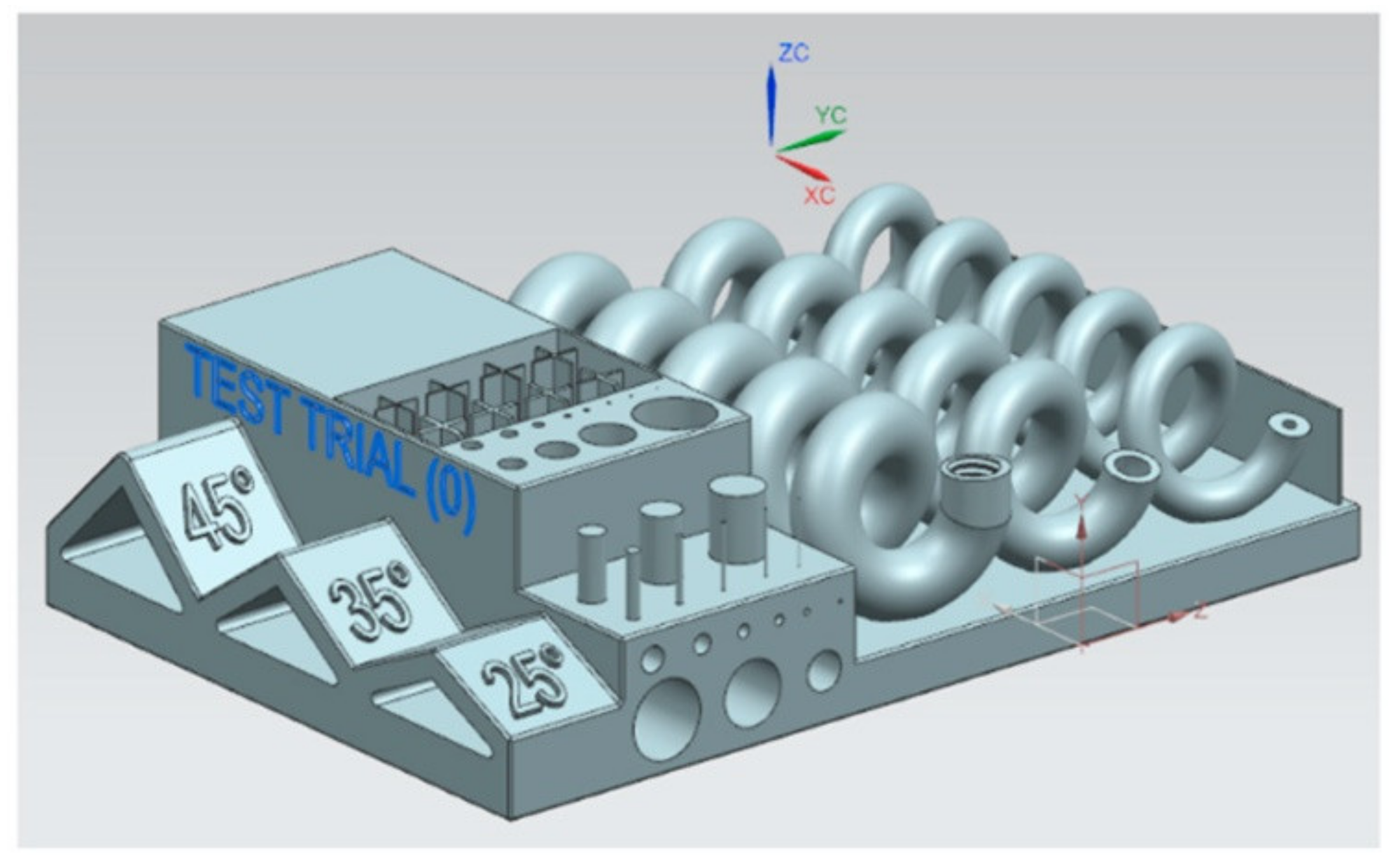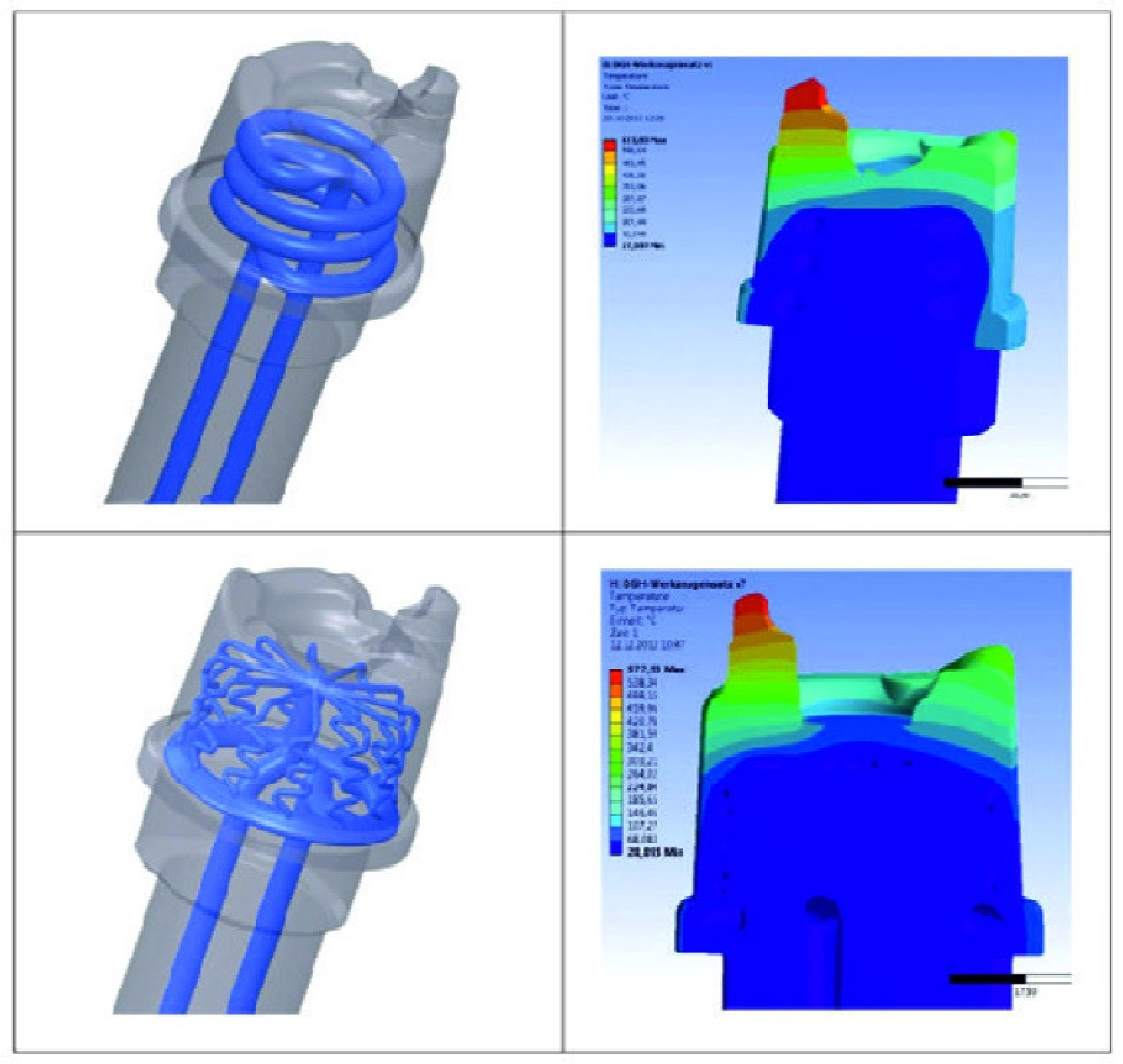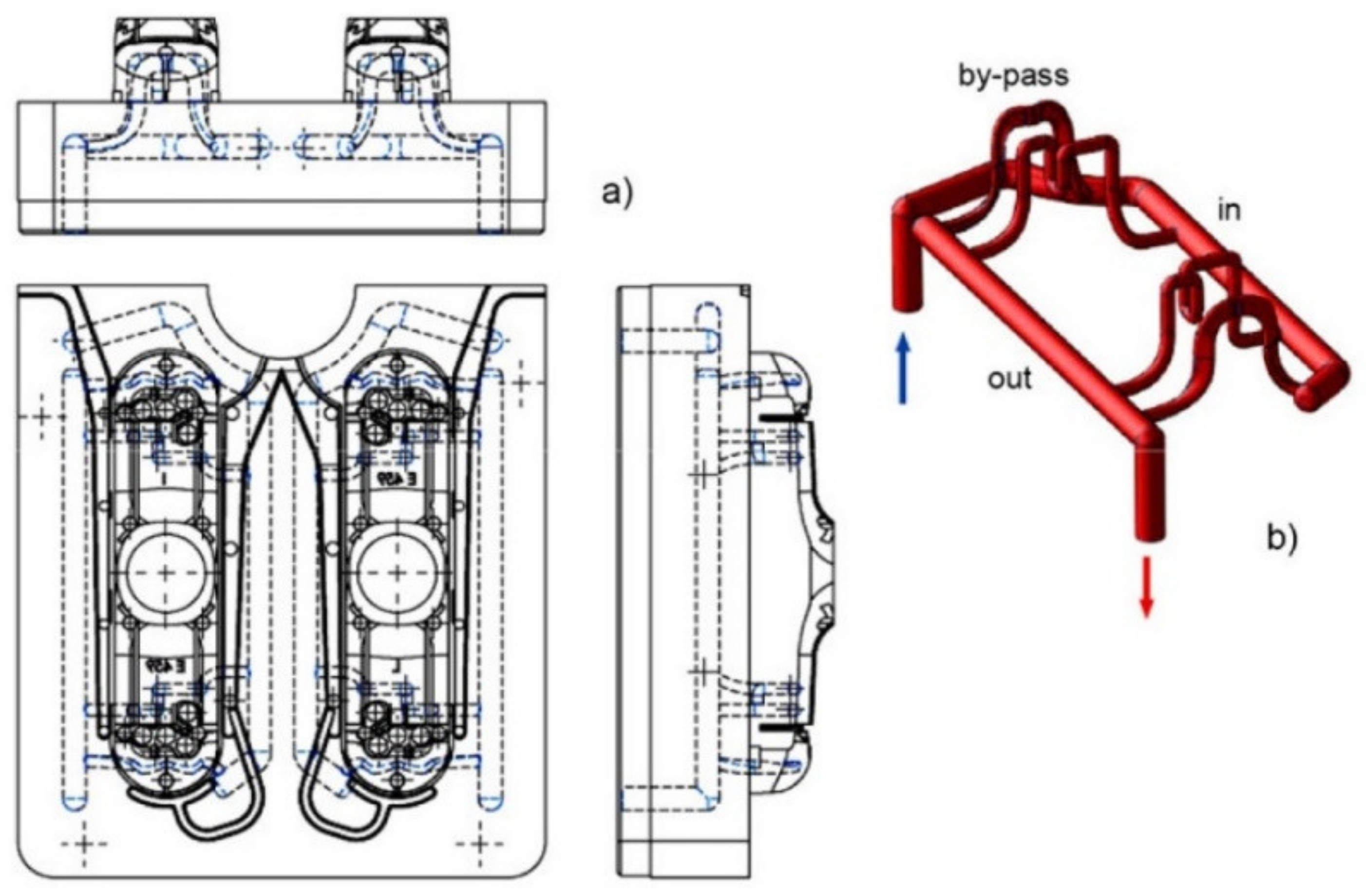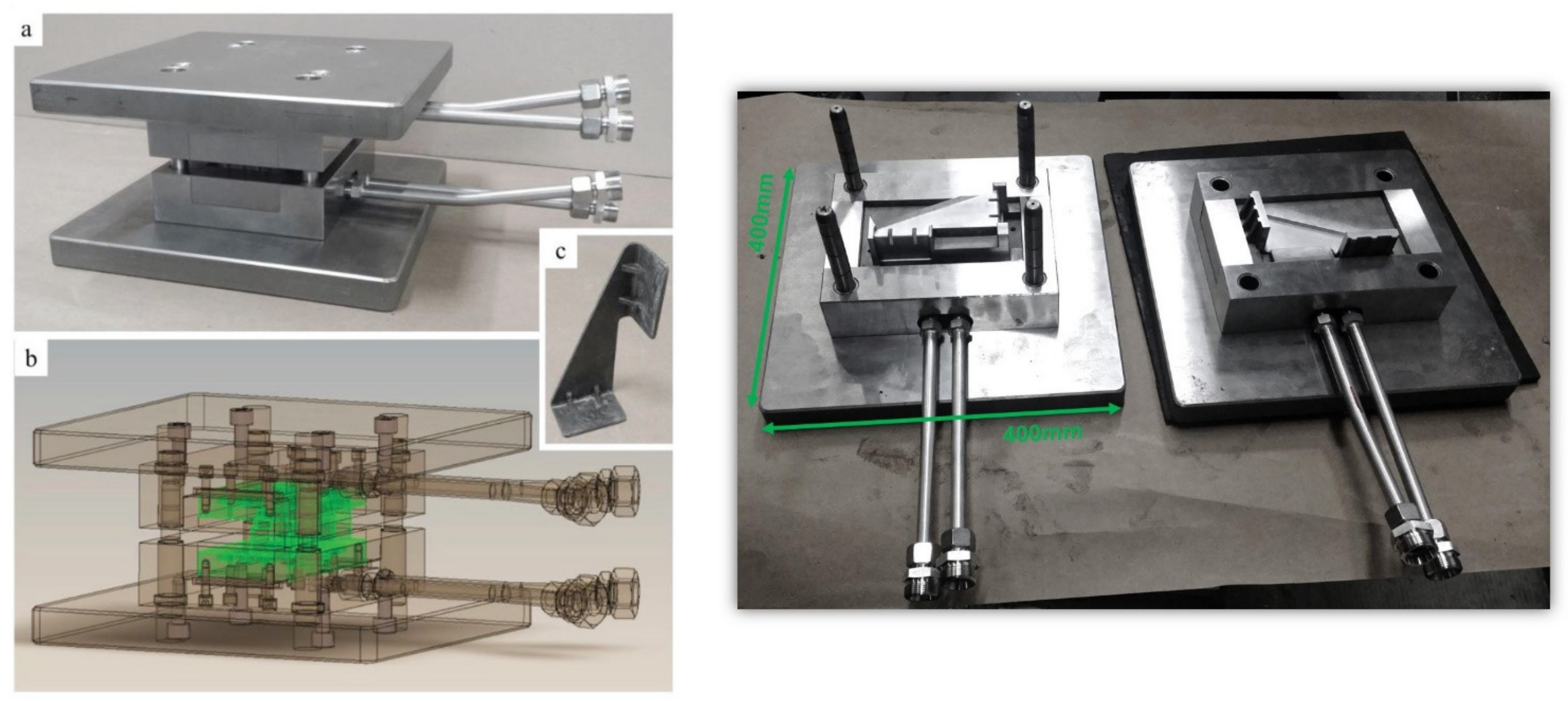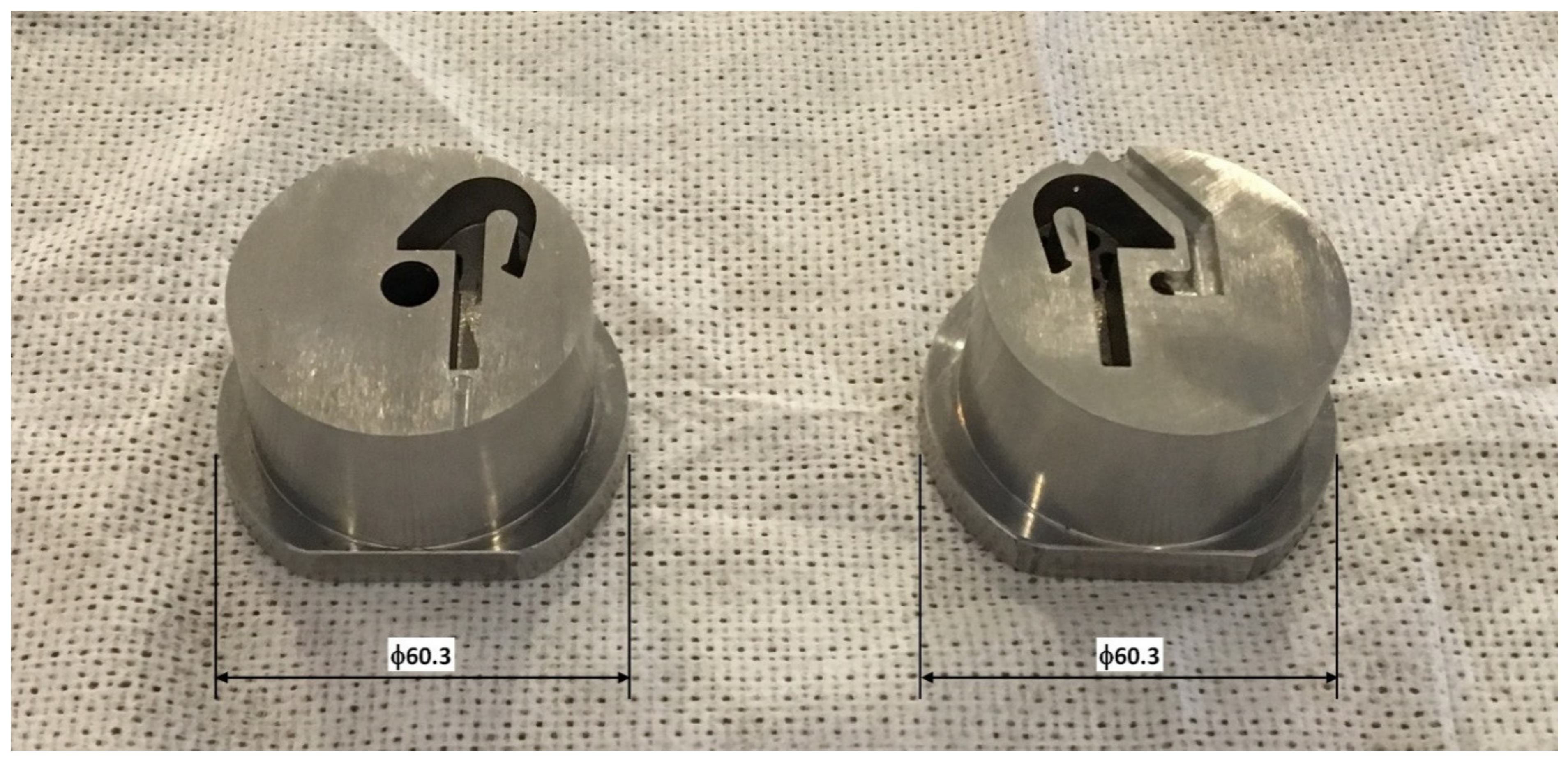Application of Laser-Based Powder Bed Fusion for Direct Metal Tooling
Abstract
1. Introduction
- A brief history of direct rapid tooling by SLS/SLM.
- A brief description of L-PBF.
- A brief account of applications and materials for production tooling.
- The L-PBF process parameters for these materials.
- The new tooling design ingredients, i.e., generative design and topology and lattice structure optimization, primarily as an amplifier of and important complement to L-PBF.
- Examples of tooling applications designed for and made by L-PBF. These examples, which are from cold and hot working and injection molding, illustrate the results of the advances made during the past 20 years and the yet greater future potential in toolmaking.
- Discussions including a future outlook and
- Conclusions.
2. Direct Rapid Tooling by Selective Laser Sintering/Melting—Brief History as a Baseline
- Computer aided design (CAD): Solid modelling.
- Enabling component technologies: Laser, ink-jet printers and motion control.
- Traditional technologies: Powdered metallurgy, welding, extrusion, CNC machining and lithography.
- Non-direct RT: SFF techniques shortening the classical/traditional toolmaking methods, e.g., using SLA to make a pattern for investment casting, resin tooling, etc., [7]. SLA, FDM (fused material deposition), LOM (laminated object manufacturing), and SLS-P (P = polymers) were used to accomplish non-direct RT.
- DRT: techniques requiring no intermediate steps in the manufacture of tools. In other words, DRT was defined as an industrial concept aimed at the realization of production tooling directly from CAD data files, with the smallest possible process chain (number of operations). Its purpose was the manufacture of tools that can be used under normal production conditions, in terms of durability, accuracy and surface quality. LG (laser generation), SLS-M (M = metals), SLS-PM (selective laser sintering of polymer-coated metal powder), and 3DP (three-dimensional printing) were used to accomplish DRT [8,9,10].
3. Laser-Based Powder Bed Fusion (L-PBF)
| Manufacturer | Model | Number and Type of Lasers | Laser Power (per Laser) (W) | Build Volume (l × w × h) (mm3) | Build Rate (cm3/hr) | Layer Thickness (μm) | Scan Speed (m/s) |
|---|---|---|---|---|---|---|---|
| 3D Systems | DMP Factory 500 Printer Module | 3 fiber | 500 | 500 × 500 × 500 1 | - | 2–200, Typical: 30, 60 & 90 | - |
| DMP Factory/Flex 350 | 1 fiber | 500 | 275 × 275 × 420 | - | 5–200, Typical: 30, 60 & 90 | - | |
| DMP Flex 100 | 1 fiber | 100 | 100 × 100 × 90 | - | 10–100 | - | |
| ProX DMP 300 | 1 fiber | 500 | 250 × 250 × 330 | - | 10–100, preset: 40 | - | |
| ProX DMP 200 | 1 fiber | 300 | 140 × 140 × 115 | - | 10–100, preset: 30 | - | |
| Additive Industries | MetalFAB1 | 1 to 4 Yb fiber | 500 | 420 × 420 × 400 | - | 20–100 | - |
| Concept Laser | X Line 2000R | 2 (cw) fibre | 1000 | 800 × 400 × 500 | - | - | - |
| M Line Factory | 4 fiber | 1000 | 500 × 500 × 400 | - | - | - | |
| M2 Multilaser | 2 (cw) fiber | 400 | 250 × 250 × 350 | - | - | - | |
| EOS | EOS M 400-4 | 4 Yb-fiber | 400 | 400 × 400 × 400 1 | 100 | 80 | 7 |
| EOS M 400 | 1 Yb-fiber | 400 | 400 × 400 × 400 1 | 50 | - | 7 | |
| EOS M 300-4 | 4 Yb-fiber | 400 | 300 × 300 × 400 | 10 | - | 7 | |
| EOS M 290 | 1 Yb-fiber | 400 | 250 × 250 × 325 1 | - | - | 7 | |
| EOS M 100 | 1 Yb-fiber | 200 | f100 × 95 1 & 2 | - | - | 7 | |
| SLM Solutions | SLM®NXG XII 600 | 12 | 1000 | 600 × 600 × 600 | 1000 | - | - |
| SLM®800 | 4 | 400 or 700 | 500 × 280 × 850 1 | Up to 171 | 20–90 | 10 | |
| SLM®500 | 4 IPG fiber | 700 | 500 × 280 × 365 1 | Up to 171 | 20–75 | 10 | |
| SLM®280 | 1, 2, 3 or dual | 400, 700, or 700 & 1000 | 280 × 280 × 365 1 | Up to 113 | 20–90 | 10 | |
| SLM®125 | 1 IPF fiber | 400 | 125 × 125 × 125 1 | Up to 25 | 20–75 | 10 | |
| Renishaw | RenAM 500Q/S | 1 or 4 Yb-fiber | 500 | 250 × 250 × 350 1 | Up to 150 | 20–100 | 10 |
| RenAM 500E | 1 Yb-fiber | 500 | 250 × 250 × 350 1 | Up to 150 | 20–100 | 10 | |
| RenAM 500M | 1 Yb-fiber | 500 | 250 × 250 × 350 1 | Up to 150 | 20–100 | 10 | |
| AM 400 | 1 | 400 | 250 × 250 × 300 1 | - | - | - | |
| AM 250 | is now replaced by AM 400 | 250 × 250 × 300 1 | - | - | - | ||
| Trumpf | TruPrint 1000 | 1 fiber | 200 | f100 × 100 1 & 2 | 2–18 | 10–50 | - |
| TruPrint 2000 | 1 fiber | 300 | f200 × 200 2 | - | 20–100 | - | |
| TruPrint 3000 | 1 fiber | 500 | f300 × 400 2 | 5–60 | 20–150 | - | |
| TruPrint 5000 | 3 fiber | 500 | f300 × 400 2 | 5–180 | 30–150 | - | |
| Manu- Facturer | Model | Powder Metals Based on… | ||||||
|---|---|---|---|---|---|---|---|---|
| Al | Co | Cu | Fe | Ni | Ti | W | ||
| 3D Systems | DMP Factory 500 Printer Module | By request | Nickel alloys | By request | ||||
| DMP Factory/Flex 350 | AlSi7Mg0.6, AlSi10Mg | CoCrF75 | - | Maraging Steel, 17-4PH, 316L | Ni625, Ni718 | Ti Gr1, Ti Gr5, Ti Gr23 | - | |
| DMP Flex 100 | - | CoCr | - | 17-4PH, 316L | - | - | - | |
| ProX DMP 300 | AlSi12 | CoCr | - | Maraging steel, 17-4PH | - | - | - | |
| ProX DMP 200 | AlSi12 | CoCr | - | Maraging steel, 17-4PH, 316 L | - | - | - | |
| Additive Industries | MetalFAB1 | AlSi10Mg, ScalmAlloy© | - | - | Tool steel 1.2709, 316L | IN718 | Ti6Al4V | - |
| Concept Laser | X Line 2000R | AlSi10Mg—Balanced & Productivity | - | - | - | Nickel 718 | Ti6AL4V Grade 23 | - |
| M Line Factory | A205 | CoCrMo | - | - | Nickel 718 CL | - | - | |
| M2 Multilaser | AlSi10Mg, AlSi7Mg | CoCrMo | - | Maraging M300, 316L, 17-4PH | Nickel 625, Nickel 718 | Ti6AL4V Grade 23 | - | |
| EOS | EOS M 400-4 | AlSi10Mg | - | - | MS1, 316L | HX, IN718 | Ti64, TiCP Grade 2 | - |
| EOS M 400 | AlSi10Mg | - | - | MS1 | IN718 | Ti64, Ti64ELI | - | |
| EOS M 300-4 | AlSi10Mg | - | - | MS1 | IN718 | Ti64 | - | |
| EOS M 290 | AlSi10Mg | MP1 | - | MS1, CX, PH1, 17-4PH, 316L | HX, IN625, IN718 | Ti64, Ti64ELI, TiCP Grade 2 | - | |
| EOS M 100 | - | SP2 | - | 316L | - | Ti64 | W1 | |
| SLM Solutions | SLM®NXG XII 600 | ALSi10Mg (No limitations) | No limitations | IN718 (No limit.) | No limitations | |||
| SLM®800 | AlSi10Mg, AlSi7Mg0.6, AlSi9Cu3 | CoCr28Mo6, SLM® MediDent | CuSn10, CuNi2SiCr | Maraging 1.2709, 316L (1.4404), 15-5PH (1.4545), 17-4PH (1.4542), H13 (1.2344), Invar 36® | HX, IN625, IN718, IN939 | Ti6Al4V ELI (Grade 23), TA15, and Ti (Grade 2) | - | |
| SLM®500 | ||||||||
| SLM®280 | ||||||||
| SLM®125 | ||||||||
| Renishaw | RenAM 500Q/S | AlSi10Mg | CoCr | - | Maraging M300, 316L | IN625, IN718 | Ti6Al4ELI | - |
| RenAM 500E | ||||||||
| RenAM 500M | ||||||||
| AM 400 | ||||||||
| AM 250 | ||||||||
| Trumpf | TruPrint 1000 | Yes to all except W + precious metal alloys + amorphous metals | ||||||
| TruPrint 2000 | Yes to all except Cu and W + amorphous metals | |||||||
| TruPrint 3000 | Yes to all except Co, Cu and W | |||||||
| TruPrint 5000 | Yes to all except Co, Cu and W | |||||||
4. Production Tooling—Applications and Materials
| AISI Classification | AISI (USA) | W.-Nr. (Germany) | Yield Strength (MPa) | Ultimate Tensile Strength (MPa) | Usual Working Hardness (HRC) | Thermal Conductivity (W/(mK)) ① | Machinability | Wear Resistance | Tougness | Hot Hardness |
|---|---|---|---|---|---|---|---|---|---|---|
| High speed steels | M3:2 | 1.3344 | - | 2210 ① (hardened to 68 HRC) | 63–66 | 26 | 4 | 8 | 3 | 8 |
| T15 | 1.3202 | - | 2240 ① (hardened to 69 HRC) | 64–68 | 21 | 1 | 9 | 1 | 9 | |
| Cold-work steels | A2 | 1.2363 | - | 1858 ② | 57–62 | 38 | 8 | 6 | 4 | 5 |
| D2 | 1.2379 | 1510 ① (hardened to 62 HRC) | 2000 ① (hardened to 62 HRC) | 58–64 | 31 | 3 | 8 | 2 | 6 | |
| O1 | 1.2510 | 1538 ③ | 1710 ③ | 57–62 | 43 | 8 | 4 | 3 | 3 | |
| W1 | 1.1545 | - | 2320 ① (hardened) | 72 ① | 48 | |||||
| Hot-work steels | H11 | 1.2343 | 1482 | 1806 | 38–55 | 42 | 8 | 3 | 9 | 6 |
| H13 | 1.2344 | - | 1820 ① (hardened to 56 HRC) | 40–53 | 29 | 8 | 3 | 9 | 6 | |
| H21 | 1.2581 | 1193 | 1379 | 50–55 | 27 | 6 | 4 | 8 | 8 | |
| H41 | - | - | 2210 ① (hardened) | 68 ① | 28 | |||||
| Shock-resisting steels | S1 | 1.2550 | - | 1840 ① (hardened to 57 HRC) | 50–58 | 41 | 8 | 4 | 8 | 5 |
| Mold steels | P20 | 1.2311 | 1172 ④ | 1310 ④ | 30–50 | 45 | 8 | 1a | 8 | 2a |
| Special purpose steels | L2 | 1.2210 | 1546 ⑤ with V | 1605 ⑤ with V | 45–60 | 44 | 8 | 1 | 7 | 2 |
| Class | Name/AISI Designation | DIN Designation | Tooling Applications |
|---|---|---|---|
| Maraging steel | 18Ni-Grade 300 (See also Böhler M722 AMPO) | 1.2709 | Cold and hot forming, injection molding etc. |
| Böhler M789 AMPO | - | Injection molding, plastic extrusion, tool holders etc. | |
| Formetrix L-40 | - | Injection molding etc. | |
| Stainless steel | 316L | 1.4404 | Injection molding etc. |
| 17-4PH | 1.4542 | Extrusion (metal powder and additives (polymers and waxes)), Injection molding etc. | |
| 420 | 1.4021 | Injection molding etc. | |
| Tool steel | M2 | 1.3343 | Cutting etc. |
| H13 | 1.2344 | Hot forging, die casting, extrusion and injection molding | |
| Böhler W360 AMPO | - | Extrusion, hot forging, hot stamping, injection molding, high-pressure die casting | |
| Uddeholm AM Corrax | - | Extrusion of plastic, injection molding |
| Class | Name/Designation | Alloying Elements (wt.%), (Fe = Balance) | ||||||||||||||||
|---|---|---|---|---|---|---|---|---|---|---|---|---|---|---|---|---|---|---|
| C | Mn | P | Si | Cr | Mo | Co | Ni | V | Al | Ti | Nb | Cu | N | S | W | Ref. | ||
| Maraging steel | 18Ni-Grade 300 (M722 AMPO, DIN 1.2709) | ≤0.03 | ≤0.15 | ≤0.01 | ≤0.10 | - | 4.5–5.20 | 8.5–10.0 | 17.0–19.0 | - | - | 0.8–1.2 | - | - | - | ≤0.01 | - | [33], see also [51] |
| M789 AMPO | <0.02 | - | - | - | 12.2 | 1.0 | - | 10.0 | - | 0.6 | 1.0 | - | - | - | - | - | [52]] | |
| Formetrix L-40 | <0.1 | - | - | - | >10.5 | <5.0 | - | <5.0 | - | - | - | <1.0 | <1.0 | <1.0 | - | - | [53] | |
| Stainless steel | AISI 316L (DIN 1.4404) | ≤0.03 | ≤2.0 | ≤0.045 | ≤1.0 | 16.5–18.5 | 2.0–2.5 | - | 10.0–13.0 | - | - | - | - | - | ≤0.11 | ≤0.03 | - | [33], see also [54] |
| 17-4PH (DIN 1.4542) | <0.07 | <1.0 | < 0.04 | <1.0 | 15.0–17.5 | - | - | 3.0–5.0 | - | - | - | +Ta 0.15–0.45 | 3.0–5.0 | - | <0.03 | - | [33], see also [51] | |
| AISI 420 (DIN 1.4021) | 0.3 | 0.72 | 0.012 | 0.79 | 12.8 | 0.5 | - | 1.0 | - | - | - | - | - | 0.09 | 0.008 | - | [56] | |
| Tool steel | AISI M2 (DIN 1.3343) | 0.9 | 0.38 | - | 0.35 | 3.97 | 4.89 | - | 0.3 | 1.82 | - | - | - | 0.25 | - | 0.03 | 6.15 | [58] |
| H13 (DIN 1.2344) | 0.32–0.45 | 0.2–0.6 | - | 0.8–1.2 | 4.75–5.5 | 1.1–1.75 | - | - | 0.8–1.2 | - | - | - | - | - | - | - | [51], see also [59] | |
| W360 AMPO | 0.5 | 0.25 | - | 0.2 | 4.5 | 3.0 | - | - | 0.55 | - | - | - | - | - | - | - | [52] | |
| P20 * (DIN 1.2311) | 0.4 | 0.83 | - | 0.45 | 1.95 | 0.33 | - | - | - | - | - | - | 0.02 | - | - | - | [60] | |
| AM Corrax | 0.03 | 0.3 | - | 0.3 | 12.0 | 1.4 | - | 9.2 | - | 1.6 | - | - | - | - | - | - | [61] | |
| Class | Name/Designation | Building Direction | Yield Strength (MPa) | Ultimate Tensile Strength (MPa) | Elongation at Break (%) | Hardness (HRC) | Impact Toughness (J) | Thermal Conductivity (W/(m.K) | Ref. | |||||
|---|---|---|---|---|---|---|---|---|---|---|---|---|---|---|
| As-Built | After Heat Treatment1 | As-Built | After Heat Treatment 1 | As-Built | After Heat Treatment 1 | As-Built | After Heat Treatment 1 | As-Built | After Heat Treatment 1 | |||||
| Maraging steel | 18Ni-300 (DIN 1.2709) | Horizontal | 1080 ± 90 | 2180 ± 40 | 1230 ± 70 | 2260 ± 30 | 13 ± 2 | 5 ± 2 | 35 ± 3 | 55 ± 3 | 64 ± 5 | 7 ± 2 | 20.9 at 25 °C | [33], see also [51] |
| Vertical | 1090 ± 50 | 2070 ± 80 | 1220 ± 20 | 2160 ± 90 | 13 ± 2 | 2 ± 1 | ||||||||
| M789 AMPO | - | - | 1720 ± 50 | - | 1850 ± 50 | - | 6 ± 2 | - | 52 ± 1 | - | 6–14 | - | [52] | |
| Formetrix L-40 | - | 1300 | 1350 | 1500 | 1650 | 14 | 10 | 46–48 | 50–52 | 60 | 18 | 16.3 at 20 °C | [53] | |
| Stainless steel | AISI 316L (DIN 1.4404) | Horizontal | 530 ± 20 2 | 370 ± 30 3 | 660 ± 20 2 | 610 ± 30 3 | 39 ± 5 2 | 51 ± 5 3 | 90 ± 6 HRB | 83 ± 4 HRB | 215 ± 15 | 220 ± 15 | 15 at 20 °C | [33], see also [54] |
| Vertical | 440 ± 20 2 | 320 ± 20 3 | 570 ± 30 2 | 540 ± 30 3 | 49 ± 5 2 | 66 ± 5 3 | ||||||||
| 17-4PH (DIN 1.4542) | Horizontal | - | 1280 ± 30 4 | - | 1450 ± 10 4 | - | 11 ± 1 4 | 32 ± 4 | 40 ± 2 4 | 71 ± 20 | 7 ± 2 4 | 18 at 100 °C | [33], see also [55] | |
| Vertical | 830 ± 110 | 1260 ± 100 4 | 1100 ± 90 | 1380 ± 20 4 | 19 ± 4 | 12 ± 2 4 | ||||||||
| AISI 420 (DIN 1.4021) | - | 700 ± 15 | 950 ± 20 | 1050 ± 25 | 1520 ± 30 | 2.5 ± 0.2 | 6.3 ± 0.2 | 55 ± 1 | 53 ± 1 | - | - | - | [56], see also [57] | |
| Tool steel | AISI M2 (DIN 1.3343) | - | - | - | 1280 | - | 0.8 | - | 57 | 64 5 | - | - | - | [58] |
| H13 (DIN 1.2344) | - | 1003 ± 8.5 | 1580 ± 14.7 2 | 1370 ± 175.1 | 1860 ± 55.8 2 | 1.7 ± 0.6 | 2.2 ± 0.8 2 | 59 ± 4.6 | 51 ± 3.7 2 | - | - | 27 at 500 °C | [59], see also [51] | |
| W360 AMPO | - | - | 1500–1670 | - | 1970–2010 | - | 6.6–8.1 | - | 55–57 | - | 8–14 | - | [52] | |
| AM Corrax | - | 760 | 1600 | 1150 | 1700 | 16 | 10 | 34 | 50 | - | 18.7 | - | [61], see also [62] | |
5. L-PBF Process Parameters
| Feature | Minimum Dimension | Min Dimension in Artifact |
|---|---|---|
| Wall thickness | 0.15 mm | 0.10 mm |
| Overhang structure | 45° | 25° |
| Circular holes (diameter) | 0.50 mm | 0.20 mm |
| Circular pins (diameter) | 0.50 mm | 0.10 mm |
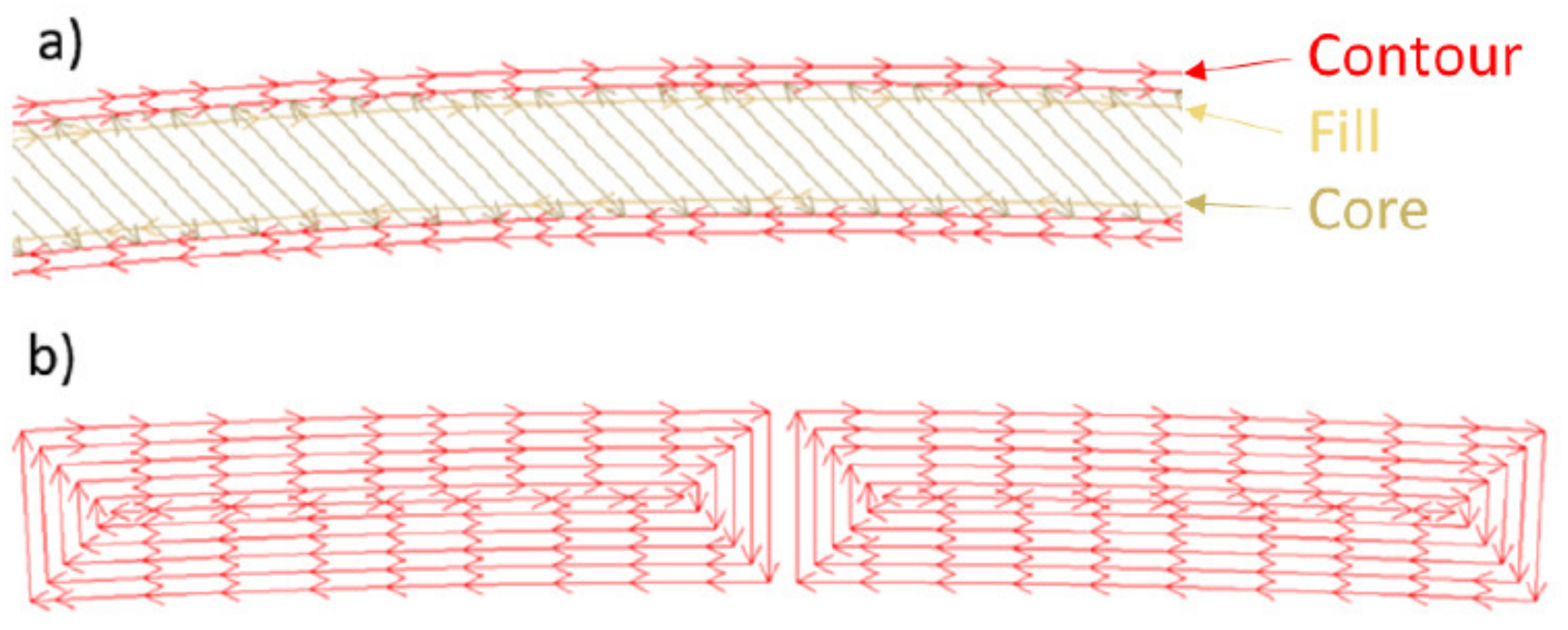
6. Tool Design for Metal Additive Manufacturing by L-PBF
- (1)
- (2)
- Topology optimize the selected design alternative, the purpose of which is to remove unnecessary material while meeting (or exceeding) the performance criteria. The goal is to optimize a part properly (weight, stiffness, frequency …) while respecting a certain set of constraints. The topology optimization process uses various mathematical algorithms and methods (each having several versions) [109,110,111,112].
- (3)
- (4)
- Produce this complex object by L-PBF (and post-processing).
7. Examples of Tooling Applications Designed for and Made by L-PBF
7.1. Cold Working
7.1.1. Piercing Punches
7.1.2. Stamping: Case 1
7.1.3. Stamping: Case 2
7.1.4. Stamping: Case 3
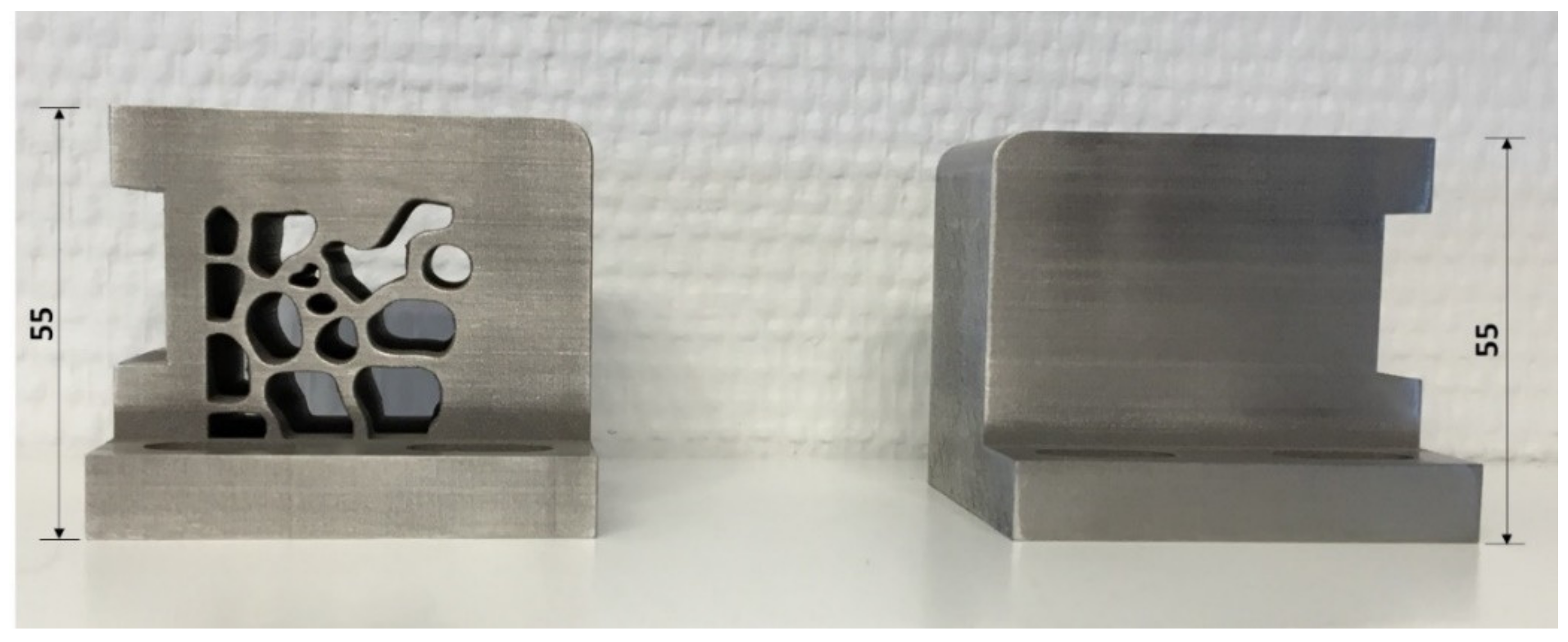
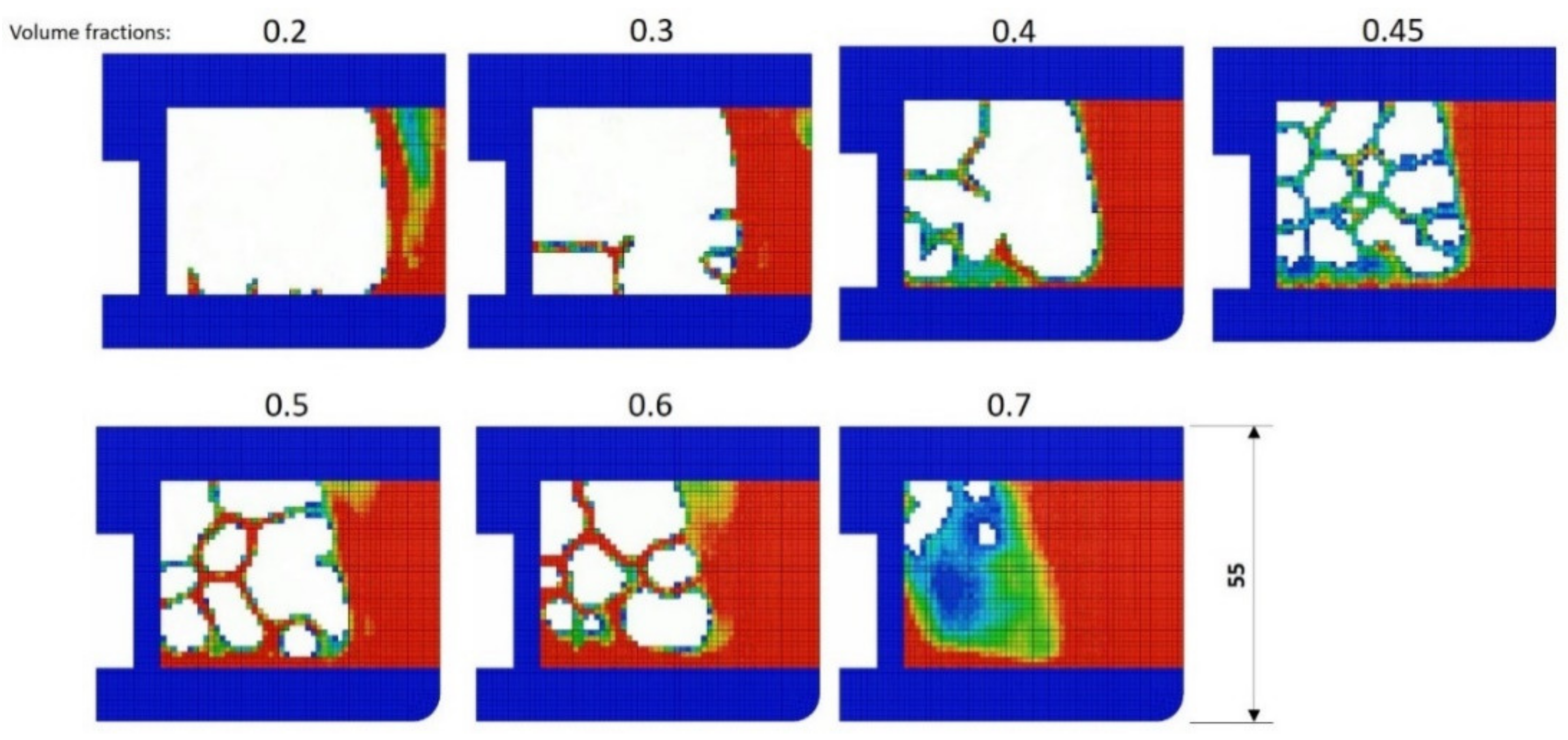
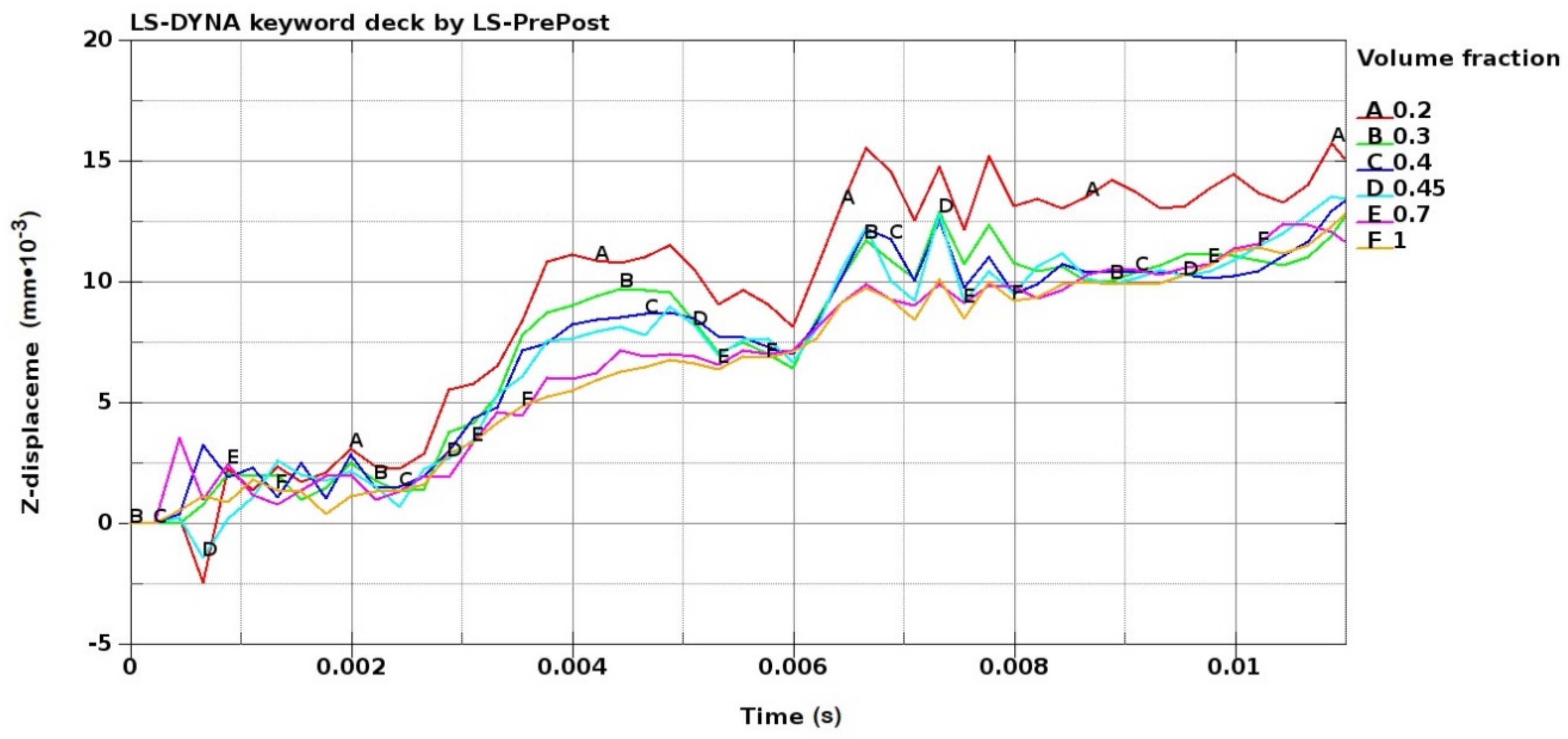
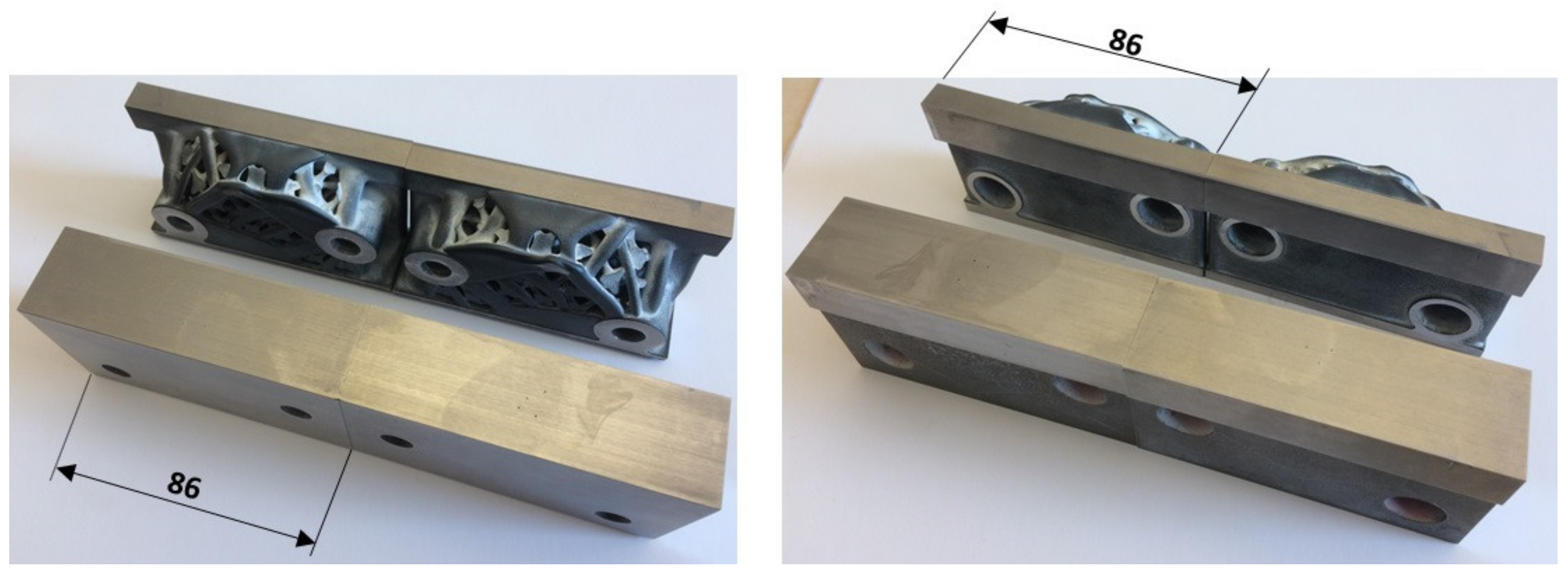

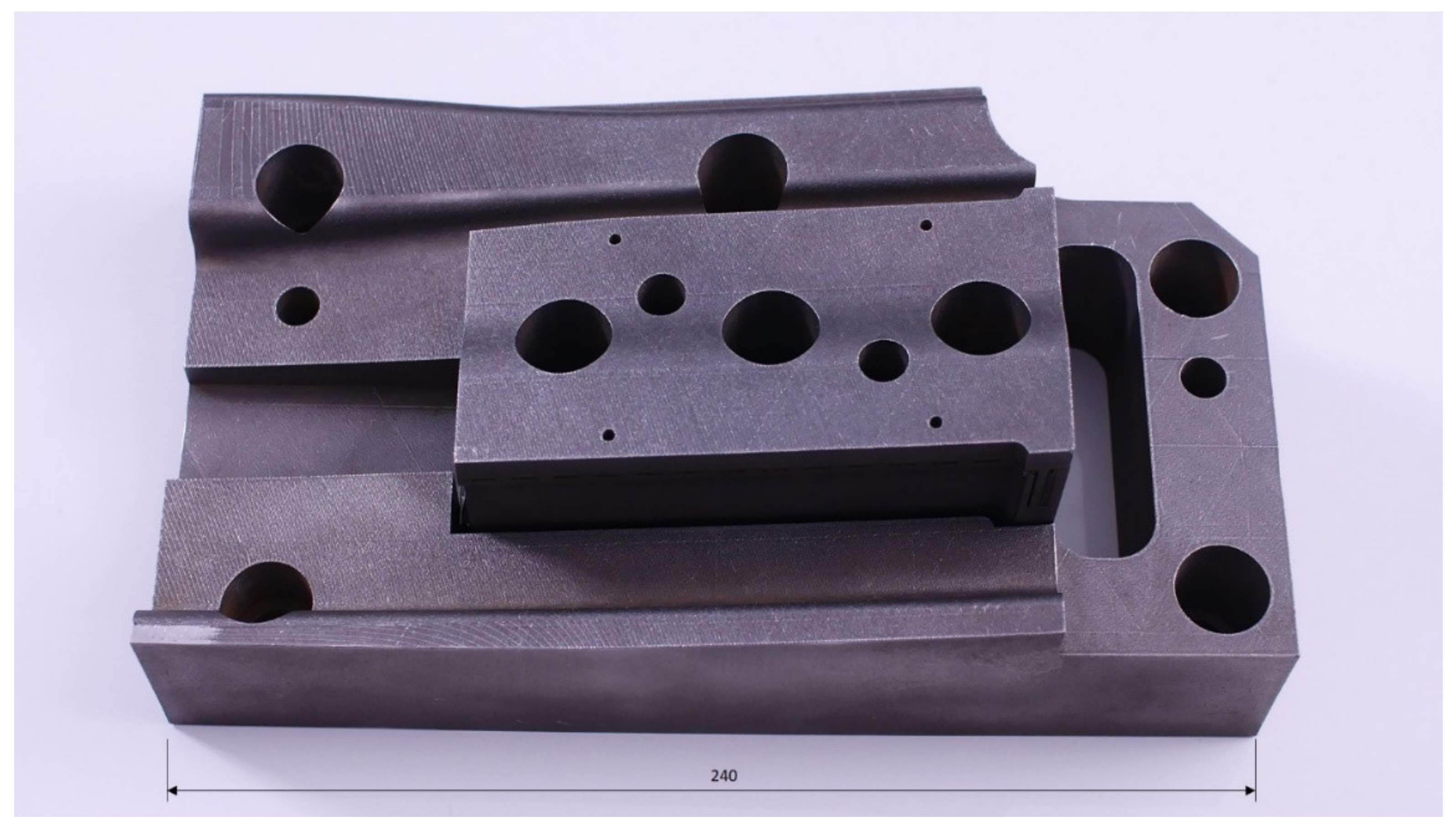
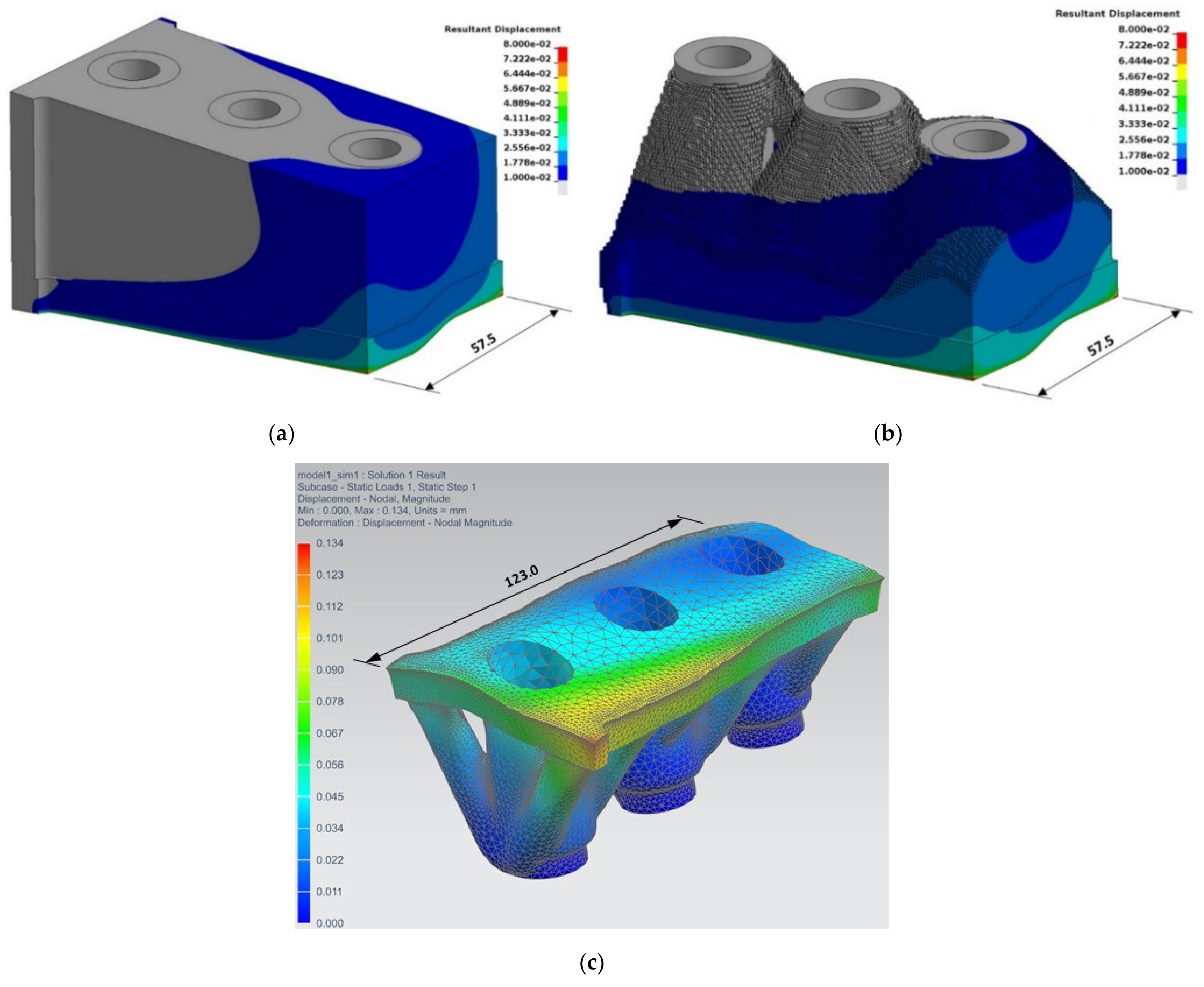
7.2. Hot Working
7.2.1. Hot Stamping
7.2.2. Extrusion: Case 1
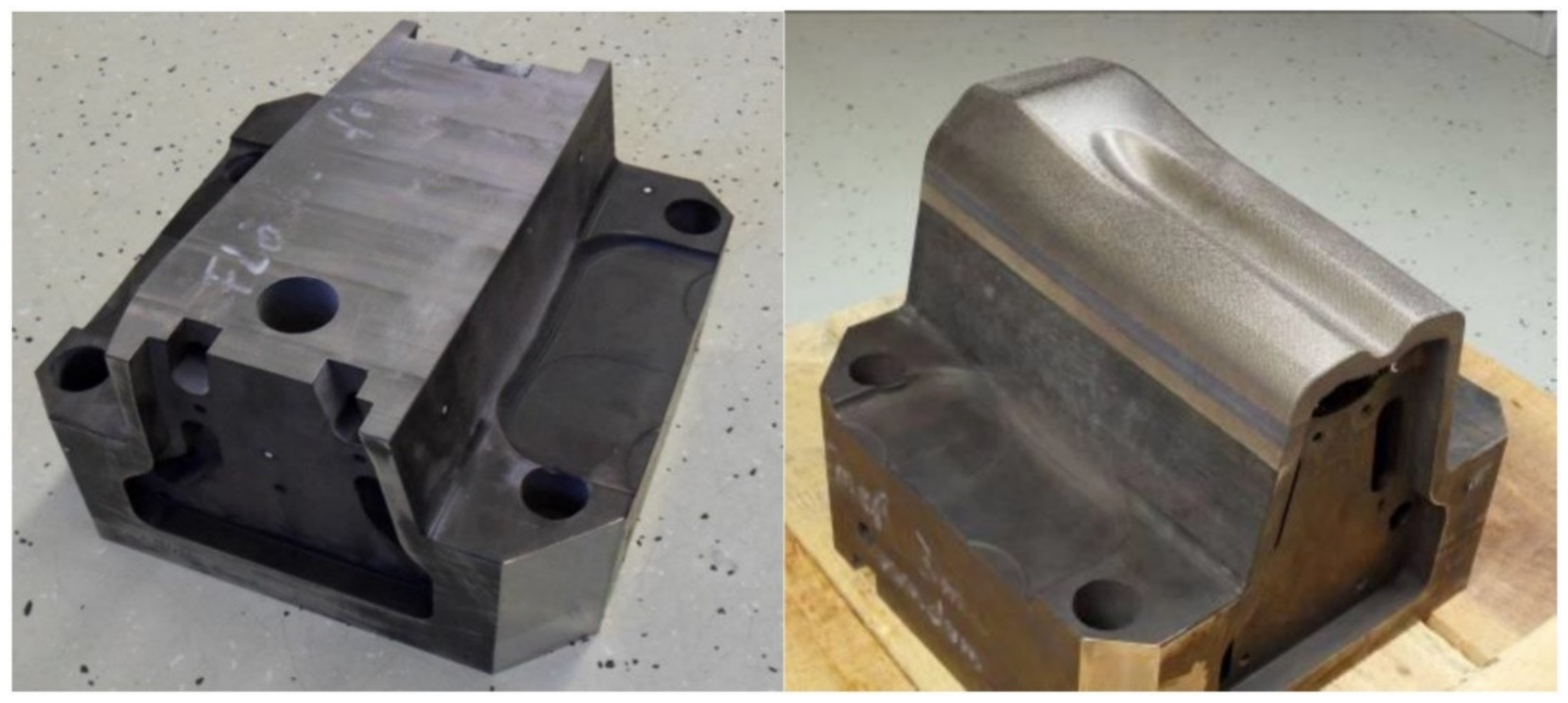
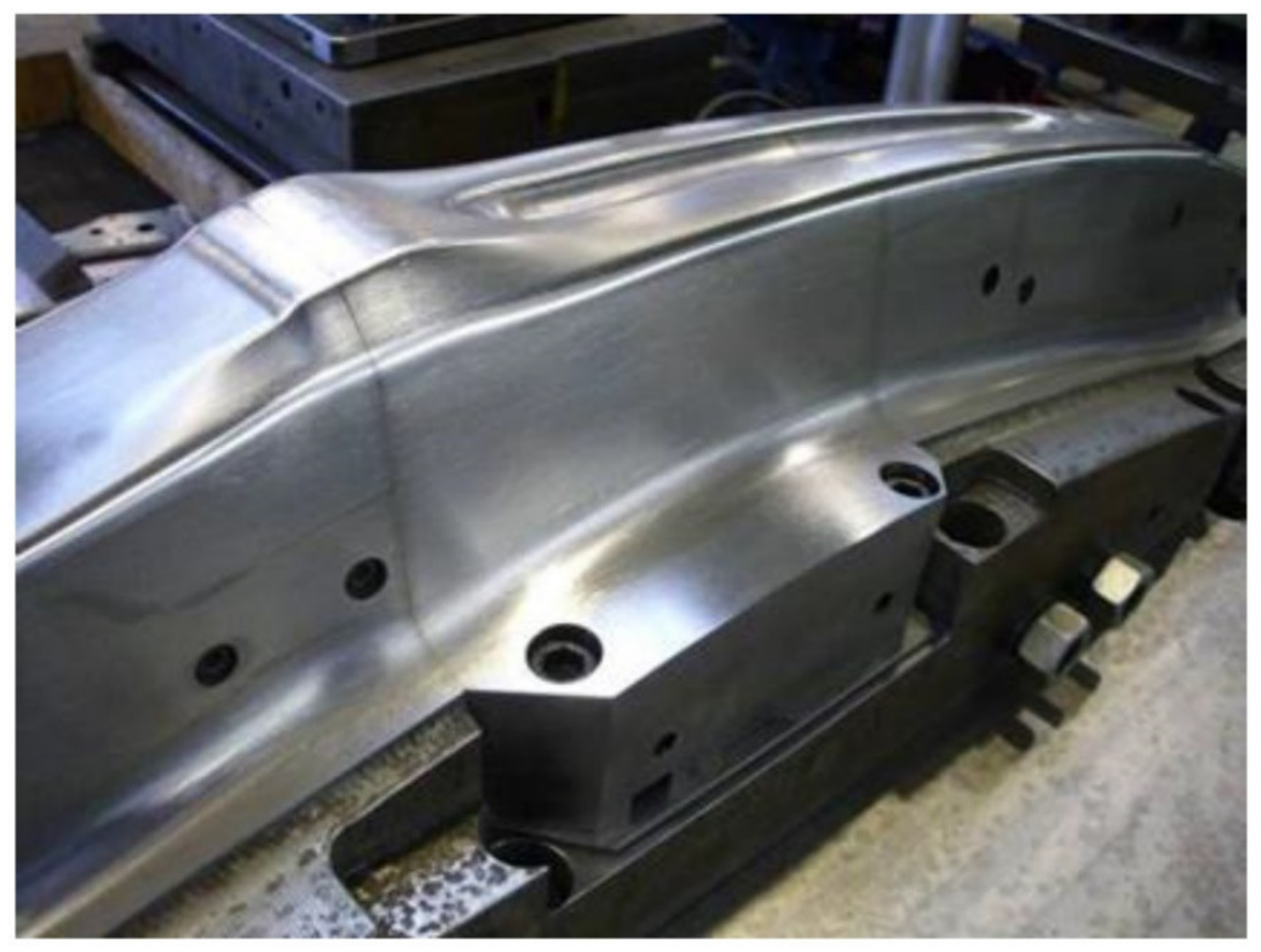
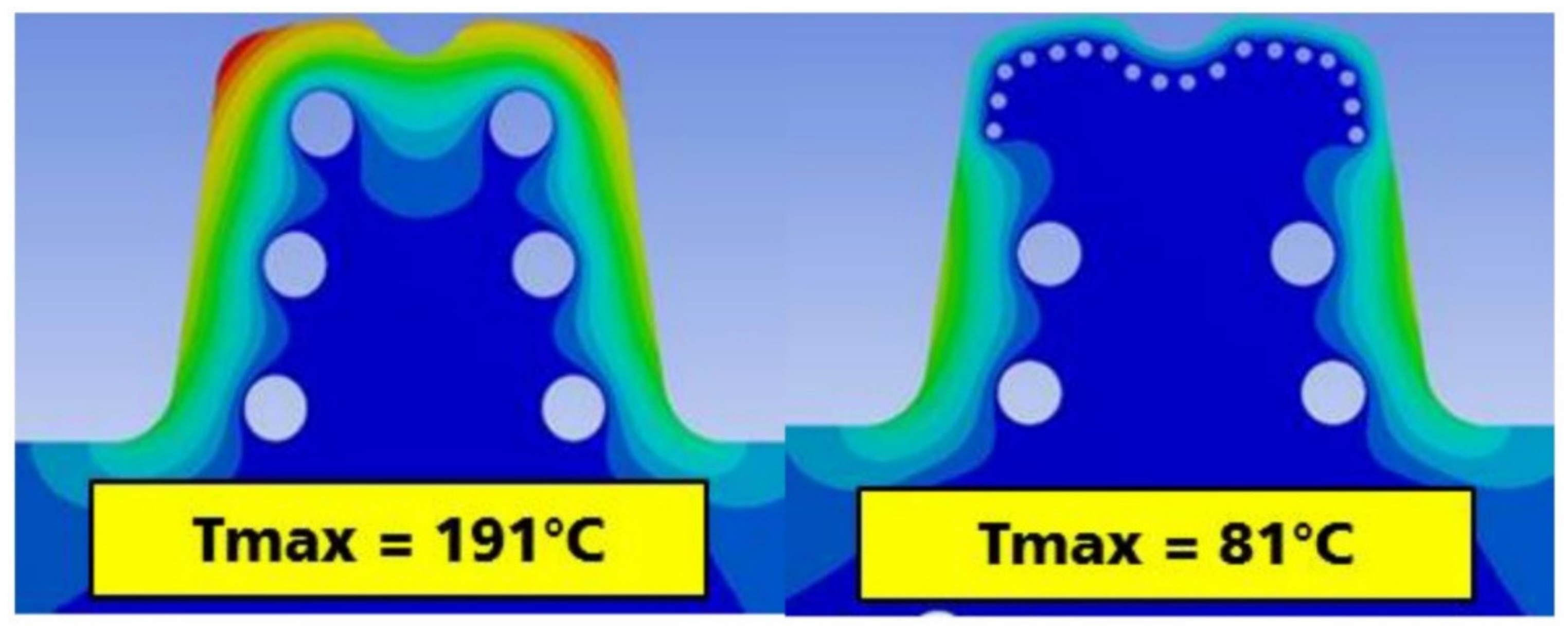
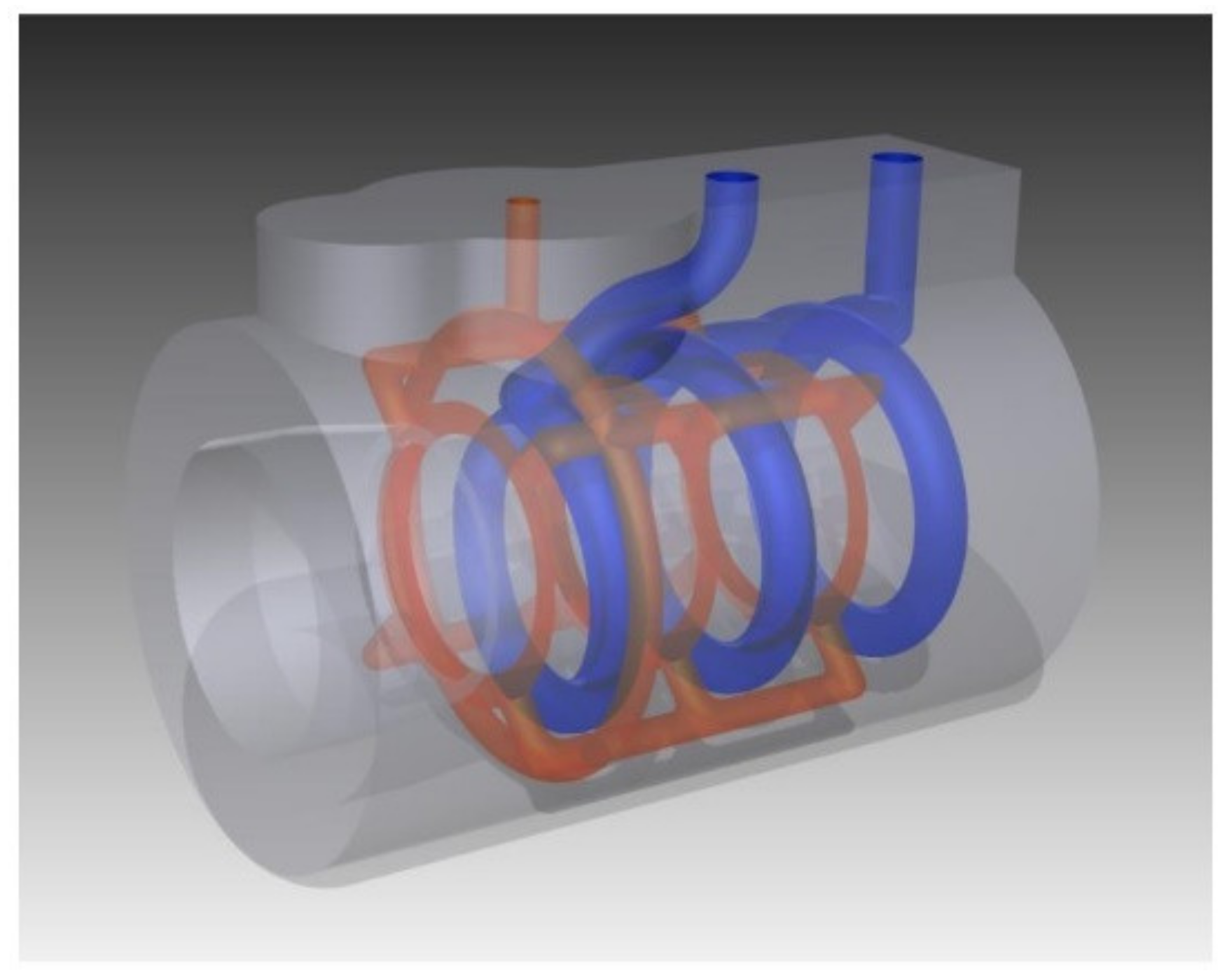
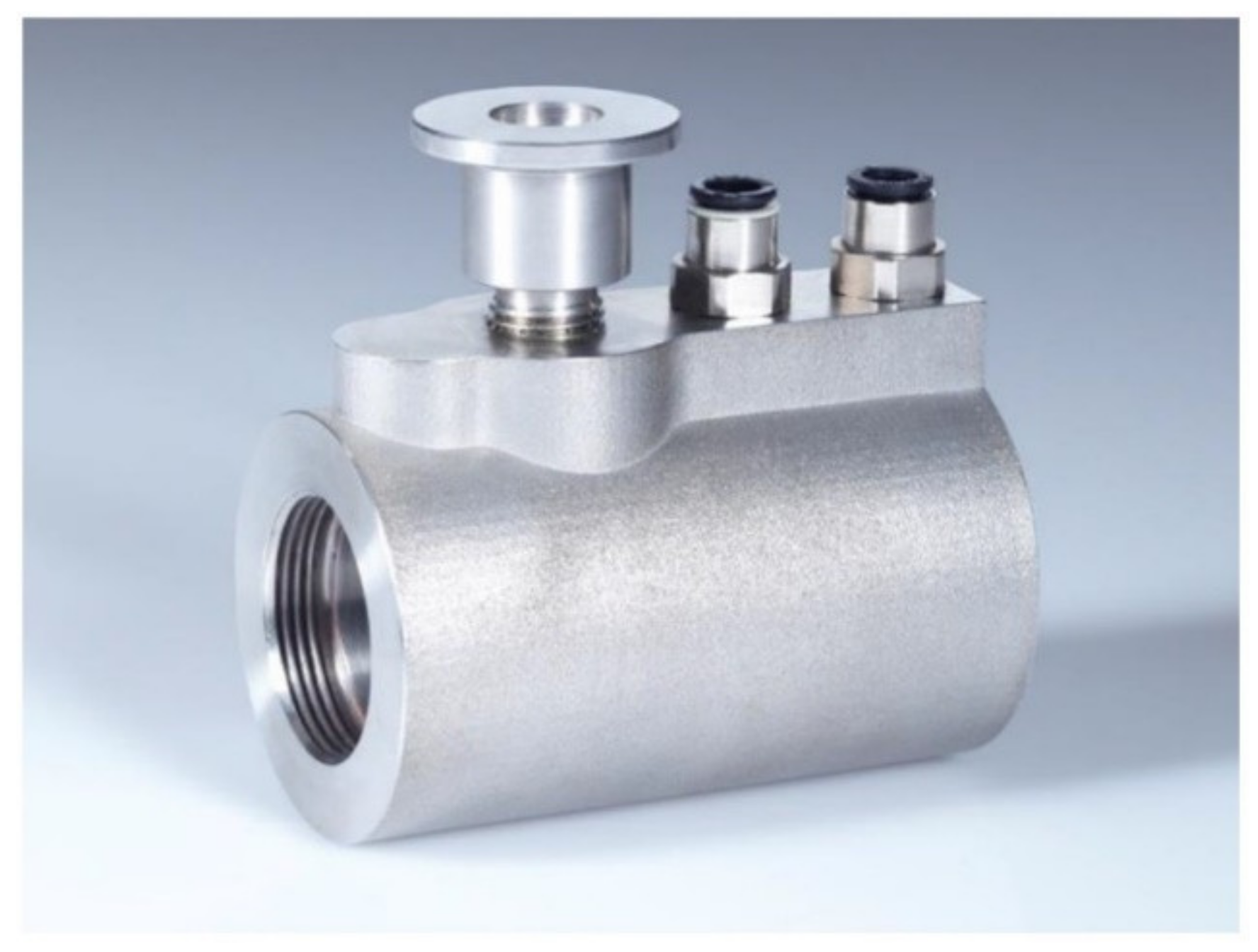
7.2.3. Extrusion: Case 2
7.2.4. Die Casting: Case 1
- FE-simulations to obtain the shortest possible distance between the cooling and the cavity on one hand and sufficient insert strength on the other.
- Thermal simulations to optimize the cooling channels in steps, ranging from spiral design to a complex system of small channels, as shown in Figure 23.

7.2.5. Die Casting: Case 2
- The upper piece, which includes the cores and the conformal cooling channels, was built by L-PBF from powders of AISI H11 (DIN 1.2343). An allowance of 0.3 mm was left for CNC finish milling after a thermal treatment.
- The lower piece, which is 25 mm thick and includes the inlet and outlet ports for the coolant, was built by CNC machining from a blank made of the same steel.
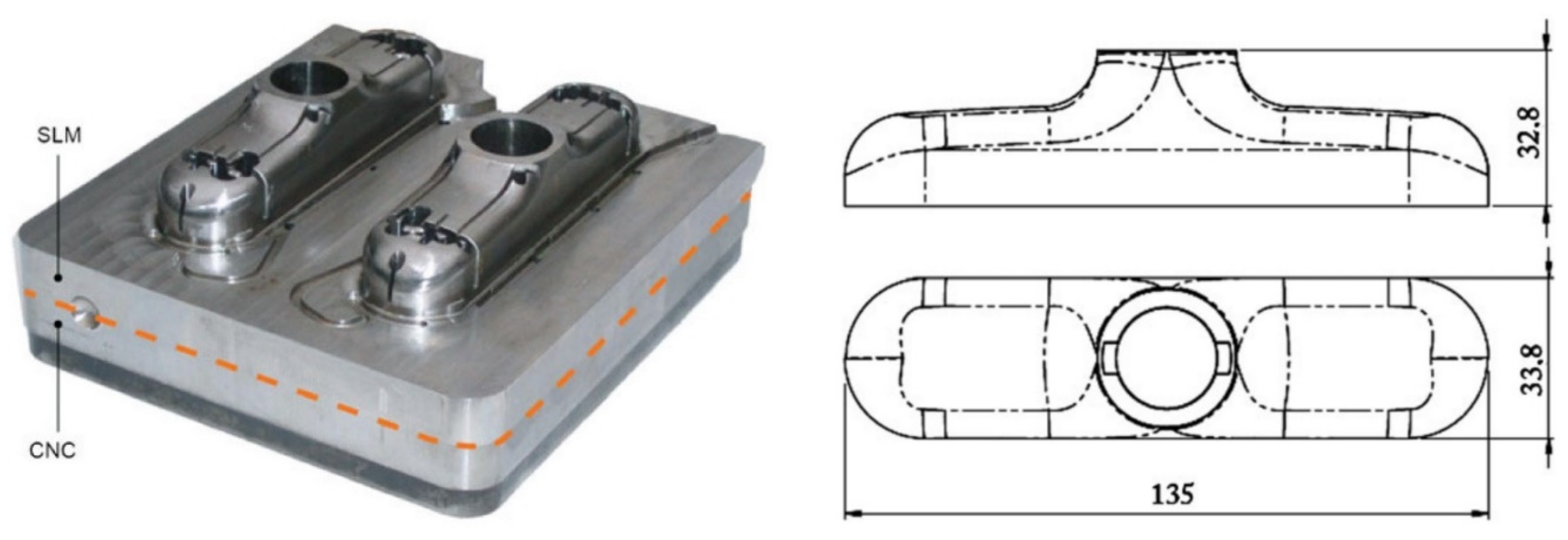
7.2.6. Sheet Molding Compound (SMC) Technology
7.2.7. Vulcanisation Mold for Tyres
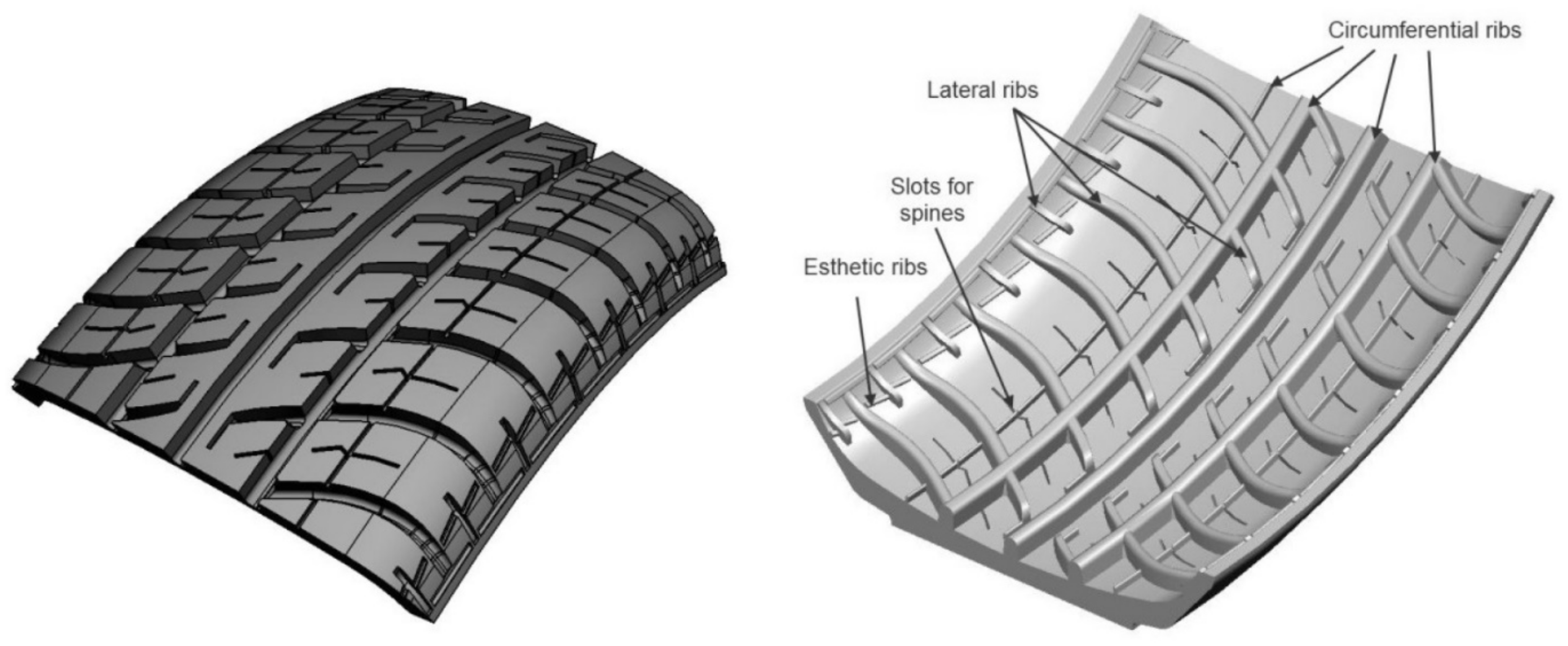
7.3. Injection Moulding
7.3.1. Injection Molding: Case 1
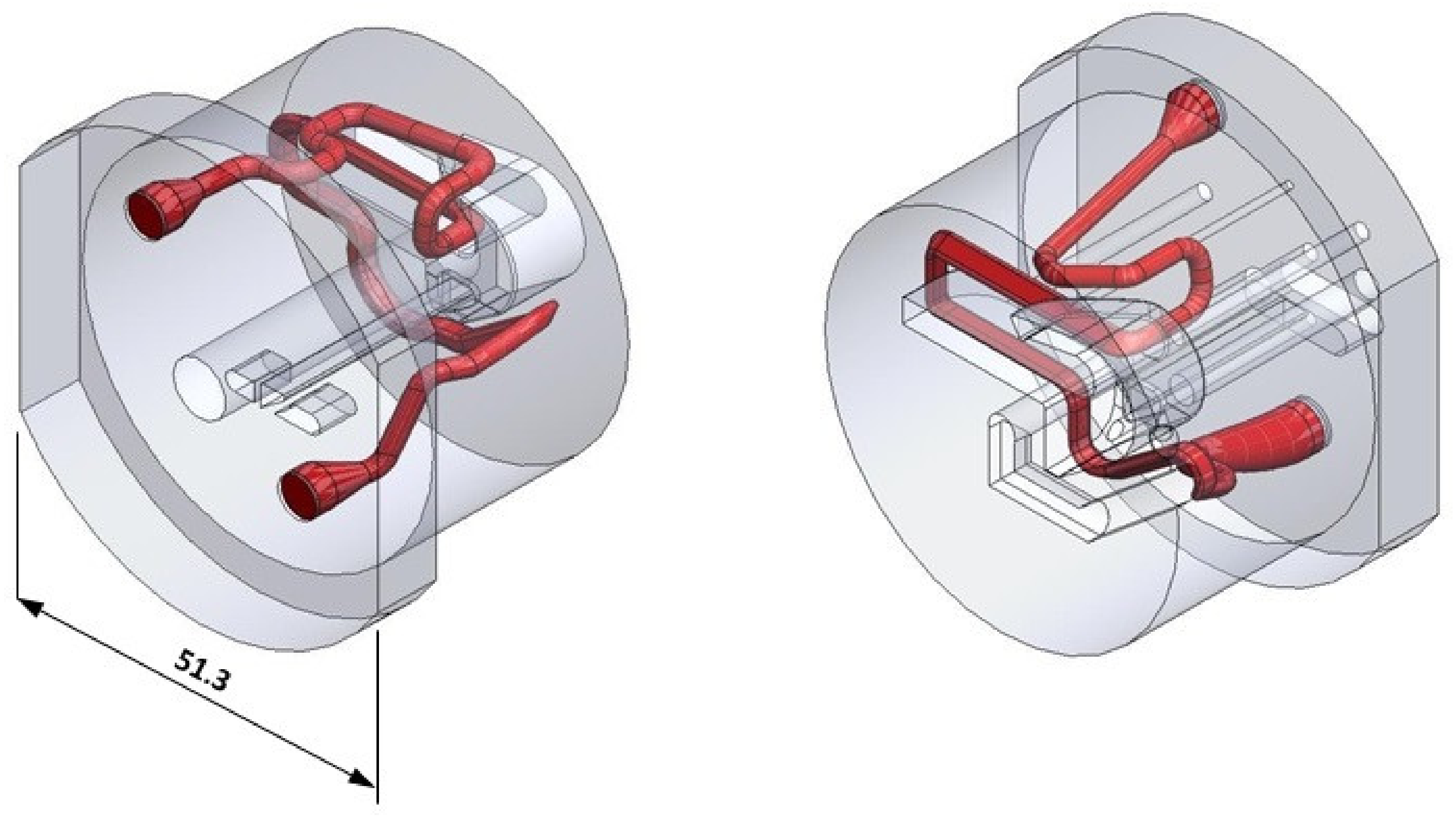
7.3.2. Injection Molding: Case 2
7.3.3. Injection Molding: Case 3
- A commercially available software, which adopts the geometry-based constraints and achieves a mass reduction of ≈50%.
- A topology optimization method developed in-house, which integrates a simplified AM process model within the standard topology optimization algorithm. The underlying thermal aspect of L-PBF is therefore included with a sequential localized steady-state thermal analysis and, thus, local overheating issues during manufacturing are avoided.
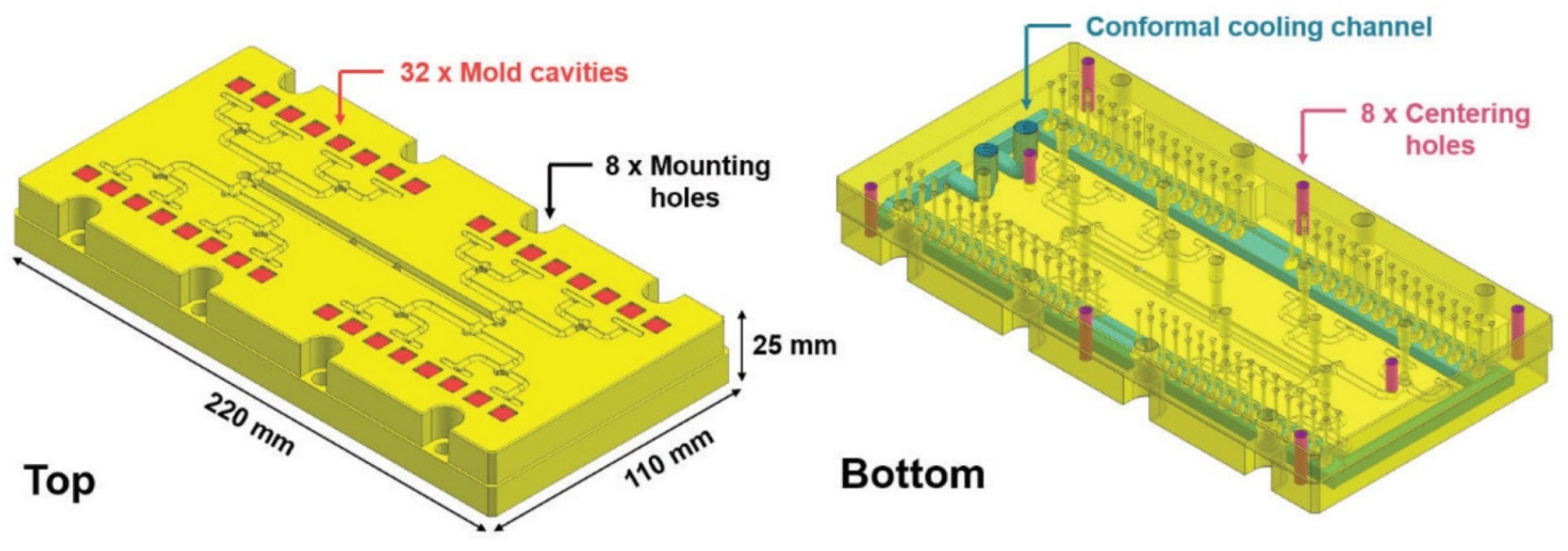
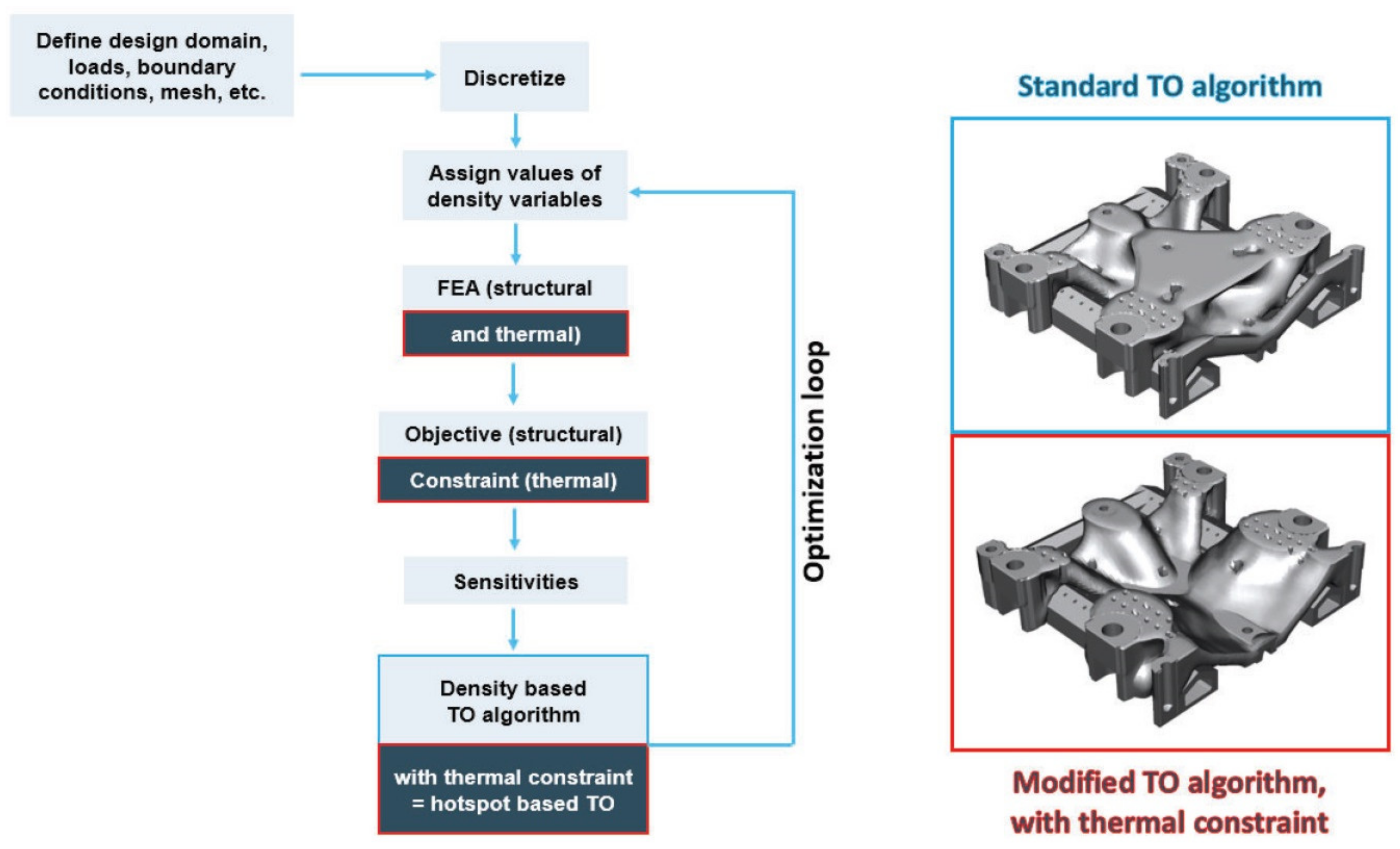
8. Discussion
- Integrated design, the objective of which is to identify assemblies or groups of parts that can be re-designed into one single part.
- Individualization, which is driven by the wish to meet different customers’ needs.
- Lightweight design, where the reduced weight improves the performance of the product.
- Efficient design, the objective of which is to improve the efficiency and performance of the product (the tool in this paper) in operation.
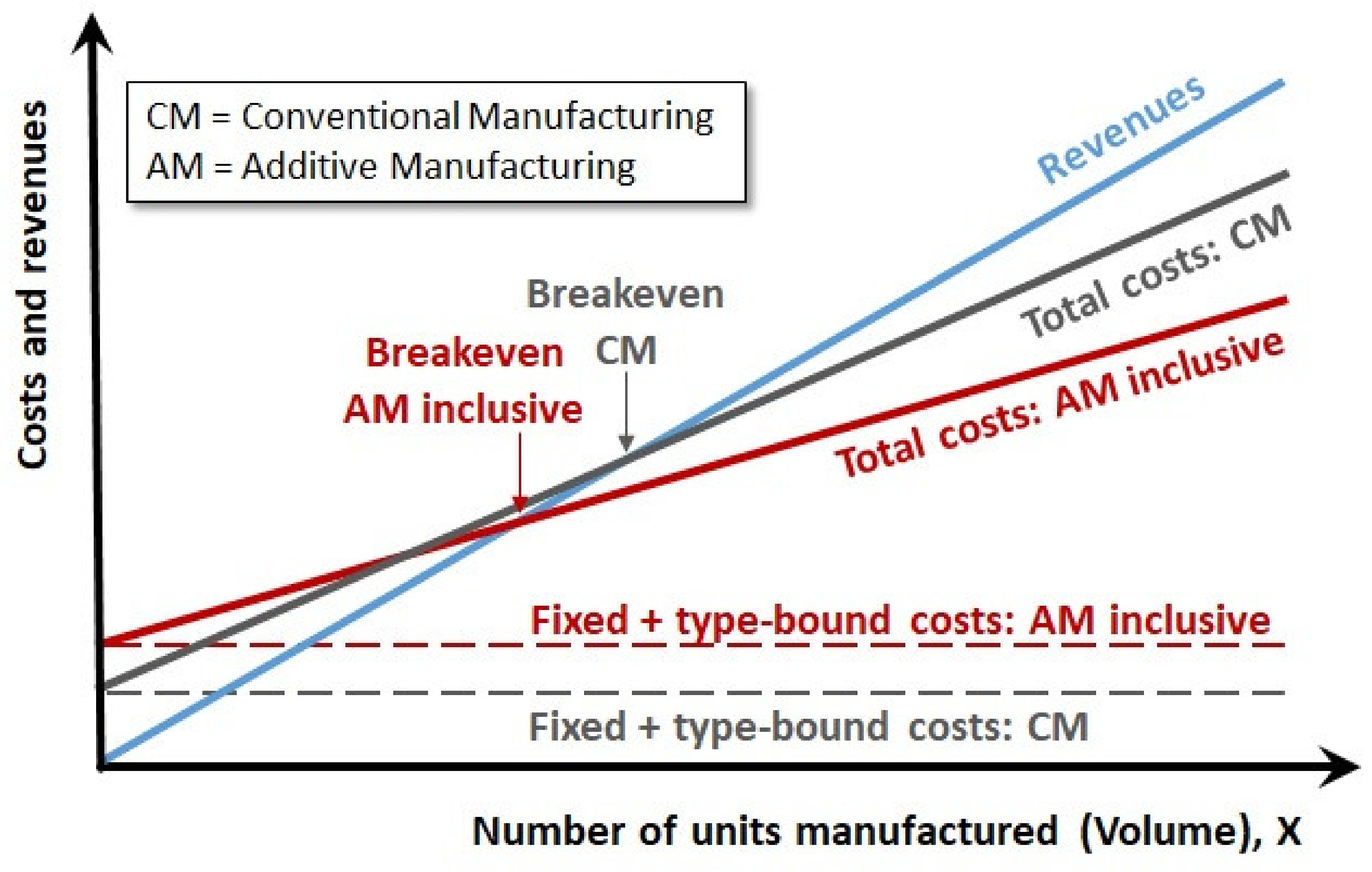
- dental/medical applications have reached the highest MRL (full- rate production),
- tooling applications the second highest MRL (low-rate production),
- aerospace industry the third highest MRL (capability in operational environment demonstrated—low rate production), and
- automotive industry the lowest MRL (technology validated in laboratory environment—basic capabilities shown).
9. Summary and Conclusions
- Generative design and topology and lattice structure optimization enable, amplify and are a complement to the design freedom provided by L-PBF.
- A focus on efficient design, the objective of which is to improve the efficiency and performance of the tooling in operation, should be the primary target in tool design. Lightweight solutions can be obtained through topology and lattice structure optimization as a complement.
- Using high tooling efficiency and performance as the primary target, L-PBF exhibits the greatest potential for hot working and injection molding tools, dies and molds.
- The tools made by L-PBF cost more than those made conventionally. However, the total costs (the part costs) can be lower than those of the parts made in conventional tools, since the cycle time is reduced significantly in the tools made by L-PBF. Hot working and injection molding are the processes in which lower total costs can be obtained.
- For cold working, e.g., (cold) stamping, both the tooling and part costs are higher with tools made by L-PBF. However, the reported lead time reduction for toolmaking through L-PBF can be used to motivate higher tooling costs for e.g., the so-called late changes in the industrialization of car body components.
- The largest objects that can be made by L-PBF are currently 600 × 600 × 600 mm3 and 800 × 400 × 500 mm3.
- The number of metal powder alloys for tooling applications is limited. Currently, maraging steels 18Ni-300 (or DIN 1.2709) and M789 AMPO, stainless steels 316L, 17-4PH and 420, and the tool steels M2, H13, P20, and AM Corrax can be selected as tool material.
- According to some investigations, the metal powder should exhibit high sphericity, a clean and smooth surface, and low amount of satellites—features that are associated with inert gas atomization. The nominal particle size distribution used for L-PBF is 10–45 μm. Other investigations show that it is possible to L-PBF metal powder with irregular particle shapes—metal powder made by water or N/air atomization—successfully. This improves the resource efficiency, since larger percentages of atomized powder can be used in L-PBF.
- Laser power (W), scan velocity (mm/s), and hatch distance (mm) between neighboring melt tracks, and the layer thickness (μm) determine the process window in L-PBF.
- The path of the scan vector and thereby the scan strategy are essential for the final quality, i.e., defect types and numbers, microstructure, residual stresses, and surface roughness.
- A chess strategy (or island scanning) is effective in reducing the residual stresses.
- User experience and expertise play a large roll in some cases, e.g., selection of a scan strategy other than the one pre-set by the machine builder might lead to better dimensional accuracy and higher quality.
- The values of the process parameters and the size of the process window which provide fully dense and high quality objects in the above-mentioned metal powder tool materials can be found in this paper (Table 8).
- The downskin surface exhibits a roughness of 20–65 μm after L-PBF. For the upskin and the top surface, a roughness of 5 μm can be achieved in L-PBF. In other words, L-PBF is not yet capable of providing the surface roughness required in tooling applications. Smaller roughness requires post-processing by machining.
- The properties of the built object are anisotropic and dependent upon the build directions and angles.
- Faces with the downskin angle <45° require support structure.
- Internal channels should be built vertically.
- Several examples from different tooling applications in cold working, hot working and injection molding made by L-PBF are showcased in this paper.
- The corrosion properties of AM-produced steels, mainly stainless steels, are superior to those of the conventionally produced materials. The research into the reasons for the improved corrosion resistance is still in its early stages.
- The so-called carbon-free DIN 1.2709 obtains a ductile martensitic microstructure and is well processable in L-PBF, while the carbon-bearing H11 and H13 display a brittle martensitic microstructure that tends to crack due to the thermal stresses built up by the high cooling rates. A pre-heating of the base plate (building platform) eliminates, however, this cracking. H11 and H13 have superior wear resistance compared to DIN 1.2709. L-PBF yields excellent performance and is suitable for small lot sizes (in tooling, only a single or a few objects are made).
- According to non-peer-reviewed assessments, metal AM is on the brink of industrialization. The manufacturing readiness level is the highest for L-PBF compared to the other metal AM methods and the second highest for L-PBF of tooling (low-rate production) compared to L-PBF in other industrial/application segments.
- Rapid tooling has made a remarkable journey to AM of production tools by L-PBF thanks to the enormous efforts in research, development, entrepreneurial endeavors and company building.
- Further research and development is required to improve toolmaking by a L-PBF inclusive process: larger object sizes that can be made by L-PBF, a larger number of powder metals that are designed for different tooling applications, lower feedstock (powder) costs, lower L-PBF processing costs, further L-PBF productivity and lead time improvement, minimized post-processing, improved surface roughness (both through L-PBF and in combination with efficient post-processing) and secured quality (including the L-PBF portion of the process). These improvements require research and development both on “single” topics, e.g., L-PBF in a multi-spot array system based on multi-diode lasers, and from a toolmaking system view, e.g., plants with a high degree of automation and eventually cyber-physically controlled smart L-PBF inclusive manufacturing systems.
Funding
Institutional Review Board Statement
Informed Consent Statement
Data Availability Statement
Acknowledgments
Conflicts of Interest
Appendix A
metals (”direct rapid tooling” OR ”metal additive manufacturing” OR ”laser powder bed fusion” OR ”selective laser melting” OR ”selective laser sintering”) (tools OR dies OR molds)
| The Database | Number of Results |
|---|---|
| Materials Science and Engineering Collection | 401 |
| Science Direct | 5366 |
| Springer Link | 929 |
| Wiley Online | 972 |
| Total | 7668 |
| The Database | Number of Results |
|---|---|
| Materials Science and Engineering Collection | |
| Peer-reviewed, English | 239 |
| Science Direct | |
| Open access, Procedia CIRP, Additive Manufacturing, Journal of Materials Processing Technology | 325 |
| Springer Link | |
| Subdiscipline Manufacturing, Machines, Tools, Processes, English | 212 |
| Wiley Online | |
| Journals, Advanced Engineering Materials, English | 112 |
| Total | 888 |
- similar papers were “neglected”, review papers were given a higher priority and industrial tooling applications were focused, and
- the remaining papers were classified based on Metallic materials for tooling applications, Design, simulations and modelling, Equipment for SLS/SLM/L-PBF, Process design and parameters, Properties and performance, and Examples of tooling applications.

- set a baseline for the review by providing a brief historical background until 2005,
- provide the capabilities of the 2020 L-PBF equipment/machines,
- provide the chemical compositions and properties of the current materials for L-PBF of production tools in cold working, hot working and injection molding,
- describe the impact of feedstock and process parameters on the properties and performance,
- provide the L-PBF process parameters for the above-mentioned tool materials,
- provide a brief description of system, part and process design,
- review some examples of tooling applications designed for and made by L-PBF,
- discuss the advances made during the past 20 years and
- draw some conclusions.
- that items 4 and 6 above should be focused on tooling applications, and
- some improvements. To facilitate these improvements, the reviewers provided additional 10 publication titles.
References
- Prinz, F.B.; Atwood, C.L.; Aubin, R.F.; Beaman, J.J.; Brown, R.L.; Fussel, P.S.; Lightman, A.J.; Sachs, E.; Weiss, L.E.; Wozny, M.J. Japanese and World Technology Evaluation Centers Panel Report on Rapid Prototyping in Europe and Japan; Analytical Chapters; Rapid Prototyping Association of the Society of Manufacturing Engineers: Baltimore, MD, USA, 1997; Volume 1, ISBN 1-883712-44-0. [Google Scholar]
- Matias, E.; Rao, B. 3D Printing: On Its Historical Evolution and the Implications for Business. In Management of the Technology Age, Proceedings of the PICMET ‘15 Conference, Portland International Center for Management of Engineering and Technology (PICMET), Portland, OR, USA, 2–6 August 2015; IEEE: Portland, OR, USA, 2015; pp. 551–558. [Google Scholar]
- Karapatis, N.P.; van Griethuysen, J.-P.S.; Glardon, R. Direct rapid tooling: A review of current research. Rapid Prototyp. J. 1998, 4, 77–89. [Google Scholar] [CrossRef]
- Kruth, J.-P. Rapid prototyping, a new application of physical and chemical processes for material accretion manufacturing. In Proceedings of the 11th International Symposium for Electromachining, Lausanne, Switzerland, 17–21 April 1995; pp. 3–28. [Google Scholar]
- Gebhardt, A. Rapid prototyping– laser-gestützte Revolution der Produktentwicklung. Laser Magazin 1996, 1, 6–9. [Google Scholar]
- Wohlers, T. Rapid Prototyping State of the Industry: 1995–96 Worldwide Progress Report; Society of Manufacturing Engineers Symposium: Dearborn, MI, USA, April 1996. [Google Scholar]
- Styger, L. Rapid Prototyping and Tooling: The Enabling Technology of the ‘90s. IEE Manufacturing Division Colloquium on Rapid Prototyping in the UK: Coventry, UK, 1994. [Google Scholar]
- Rapid Prototyping: Rewriting the Rule Book; IEE Manufacturing Division Colloquium on Rapid Prototyping in the UK: Coventry, UK, 1994.
- CRIF-Liège Information Leaflet; CRIF: Liège, Belgium, 1996.
- Lohner, A. Laser sintering ushers in new route to PM parts. Metal Powder Rep. 1997, 52, 24–30. [Google Scholar]
- Girouard, D. The SLSTM selective laser sintering process: Technology, applications, and materials for advanced rapid prototyping. In Proceedings of the IBEC ‘93, Detroit, MI, USA, 21–23 September 1993; pp. 10–14. [Google Scholar]
- Shellabear, M.; Nyrhilä, O. Dmls—Development history and state of the art. In Proceeding of the 4th LANE (Laser Assisted Net Shape Engineering), Erlangen, Germany, 21–24 September 2004. [Google Scholar]
- Wohler, T.; Gornet, T. History of additive manufacturing. Wohler Rep. 2016, 24, 118. [Google Scholar]
- Hejmadi, U.; McAlea, K. Selective laser sintering of metal molds: The RapidToolTM process. In Proceedings of the Annual International Solid Freeform Fabrication Symposium, Austin, TX, USA, 12–14 August 1996; pp. 97–104. [Google Scholar]
- Nyrhilä, O.; Syrjälä, S. Manufacture of Dimensionally Precise Pieces by Sintering. U.S. Patent 5,061,439, 5 December 1990. [Google Scholar]
- Holger, D.; Pilz, R.; Eleser, N.S. Rapid tooling of EDM electrodes by means of selective laser sintering. Comput. Ind. 1999, 39, 35–45. [Google Scholar]
- Majewski, C.; Hopkinson, N. The Effect of Layer Thickness on Ejection Forces for Injection Moulded Parts Made Using DMLS Tools. In Proceedings of the Annual International Solid Freeform Fabrication Symposium, Austain, TX, USA, 5–7 August 2002; pp. 73–82. [Google Scholar]
- King, D.; Tansey, T. Rapid tooling: Selective laser sintering injection tooling. J. Mater. Process. Technol. 2003, 132, 42–48. [Google Scholar] [CrossRef]
- Kruth, J.-P.; Mercelis, P.; Van Vaerenbergh, J.; Froyen, L.; Rombouts, M. Advances in selective laser sintering. In Proceedings of the 1st International Conference on Advanced Research in Virtual and Rapid Prototyping (VR@P), Leiria, Portugal, 1–4 October 2003; pp. 59–69. [Google Scholar]
- Meiners, W.; Wissenbach, K.; Gasser, A. Selective Laser Sintering at Melting Temperature. U.S. Patent 6,215,093, 10 April 2001. [Google Scholar]
- Neikov, O.D. Powders for Metal Additive Processing. In Handbook for Non-Ferrous Metal Powders—Technologies and Applications, 2nd ed.; Neikov, O.D., Naboychenko, S.S., Yefimov, N.A., Eds.; Elsevier: Amsterdam, The Netherlands, 2019; pp. 373–399. ISBN 978-0-08-100543-9. [Google Scholar]
- Meiners, W.; Over, C.; Wissenbach, K.; Poprawe, R. Direct Generation of Metal Parts and Tools by Selective Laser Powder Remelting (SLPR). In Proceedings of the Annual International Solid Freeform Fabrication Symposium, Austain, TX, USA, 9–11 August 1999; pp. 655–661. [Google Scholar]
- Kruth, J.-P.; Vandenbroucke, B.; Van Vaerenbergh, J.; Mercelis, P. Benchmarking of different sls/slm processes as rapid manufacturing techniques. In Proceeding of International Conference Polymers & Moulds Innovations (PMI), Gent, Belgium, 20–23 April 2005; pp. 1–7. [Google Scholar]
- Sprinkle, T. The 5 Most Important Standards in Additive Manufacturing. ASTM Standardization News. 11 May 2020. Available online: https://www.astm.org/standardization-news/?q=features/5-most-important-standards-additive-manufacturing-.html (accessed on 25 November 2020).
- ISO. International Standard ISO 52900, 2016—Additive manufacturing—General principles—Terminology (ISO/ASTM 52900, 2015, IDT); ISO: Geneva, Switzerland, 2016. [Google Scholar]
- ISO. International Standard ISO 17296-2, 2016—Additive manufacturing—General principles—Part 2, Overview of process categories and feedstock (ISO 17296-2, 2015); ISO: Geneva, Switzerland, 2016. [Google Scholar]
- Ålgårdh, J.; Strondl, A.; Karlsson, S.; Farre, S.; Joshi, S.; Andersson, J.; Ågren, J. State-of-the-Art for Additive Manufacturing of Metals; Report 2016-03898—State-of-the-Art—Version 2.1; Swedish Arena for Additive Manufacturing of Metals: Stockholm, Sweden, 2017. [Google Scholar]
- Criales, L.E.; Arısoy, Y.M.; Lane, B.; Moylan, S.; Donmez, A.; Özel, T. Laser powder bed fusion of nickel alloy 625, Experimental investigations of effects of process parameters on melt pool size and shape with spatter analysis. Int. J. Mach. Tool Manuf. 2017, 121, 22–36. [Google Scholar] [CrossRef]
- Schwarze, D. Auswirkungen der Bauraumvorheizung auf die thermomechanischen Bauteileigenschaften; Anwender Zentrum Augsburg, IWB: München, Germany, 2010. [Google Scholar]
- Over, C. Generative Fertigung von Bauteilen aus Werkzeugstahl X38CrMoV5-1 und Titan TiAl6V4 mit “Selective Laser Melting”; Shaker: Aachen, Germany, 2003. [Google Scholar]
- Niendorf, T.; Leuders, S.; Riemer, A.; Richard, H.A.; Tröster, T.; Schwarze, D. Highly Anisotropic Steel Processed by Selective Laser Melting. Metall. Mater. Trans. B 2013, 44B, 794–796. [Google Scholar] [CrossRef]
- Langefeld, B.; Moehrle, M.; Balzer, C.; Schildbach, P. Advancements in Metal 3D Printing—Beyond Powder Bed—Additive Manufacturing on the Brink of Industrialization; Roland Berger: Munich, Germany, 2018. [Google Scholar]
- 3D Systems, Printers and Materials Specifications. Available online: https://www.3dsystems.com (accessed on 27 November 2020).
- Additive Industries, Printers and Materials Specifications. Available online: https://www.additiveindustries.com (accessed on 27 November 2020).
- Concept Laser, Printers and Materials Specifications. Available online: https://www.ge.com/additive/who-we-are/concept-laser (accessed on 27 November 2020).
- EOS (Electro Optical Systems), Printers and Materials Specifications. Available online: https://www.eos.info/en (accessed on 27 November 2020).
- SLM Solutions, Printers and Materials Specifications. Available online: https://www.slm-solutions.com/ (accessed on 27 November 2020).
- Renishaw, Printers and Materials Specifications. Available online: https://www.renishaw.com/en/metal-3d-printing--32084 (accessed on 27 November 2020).
- Trumpf, Printers and Materials Specifications. Available online: https://www.trumpf.com/en_INT/products/machines-systems/additive-production-systems (accessed on 27 November 2020).
- Liljengren, M.; Kjellsson, K.; Johansson, T.; Asnafi, N. Die Materials, Hardening Methods and Surface Coatings for Forming of High, Extra High & Ultra High Strength Steel Sheets (HSS/EHSS/UHSS). In Proceedings of the Annual Conference of the International Deep Drawing Research Group’s (IDDRG), Porto, Portugal, 19–21 June 2006; pp. 507–603. [Google Scholar]
- Asnafi, N.; Johansson, T.; Miralles, M.; Ullman, A. Laser Surface-Hardening of Dies for Cutting, Blanking or Trimming of Uncoated DP600. Proceeding of the Recent Advances in Manufacture & Use of Tools & Dies and Stamping of Steel Sheets, Olofström, Sweden, 5–6 October 2004; pp. 169–190. [Google Scholar]
- Asnafi, N. Tooling and Technologies for Processing of Ultra High Strength Sheet Steels. In Proceedings of the Tools and Technologies for Processing Ultra High Strength Materials, Graz University of Technology, Graz, Austria, 19–21 September 2011. [Google Scholar]
- Sjöström, J. Chromium Martensitic Hot-Work Tool Steels—Damage, Performance and Microstructure. Ph.D. Thesis, Karlstad University Studies, Karlstad, Sweden, 2004; p. 52, ISBN 91-85335-21-5. [Google Scholar]
- Fuchs, K.-D. Hot-Work Tool Steels with Improved Properties for Die casting Applications. In Proceedings of the 6th International Conference on Tooling, Karlstad, Sweden, 10–13 September 2002; pp. 17–26. [Google Scholar]
- Klobčar, D.; Tušek, J.; Taljat, B. Thermal fatigue of materials for die-casting tooling. Mater. Sci. Eng. A 2008, 472, 198–207. [Google Scholar] [CrossRef]
- Vasco, J.; Capela, C.; Bártolo, P.; Granja, D. Material Selection for High Performance Moulds. In Proceedings of the SPE Meeting Improving Quality and Tool Efficiency within Injection Moulding K2007, Düsseldorf, Germany, 25 October 2007; pp. 1–7. [Google Scholar]
- Rebeggiani, S. On Polishability of Tool Steels; Chalmers University of Technology: Göteborg, Sweden, 2013; ISBN 978-91-7385-828-1. [Google Scholar]
- Roberts, G.; Krauss, G.; Kennedy, R. Tool Steels, 5th ed.; ASM International: Novelty, OH, USA, 1998; ISBN 978-0-87170-599-0. [Google Scholar]
- Højerslev, C. Tool steels. Risoe-R, No. 1244(EN); Risø National Laboratory, Forskningscenter Risoe: Roskilde, Denmark, 2001. [Google Scholar]
- The online Material Properties Database MakeItFrom.com. Available online: https://www.makeitfrom.com (accessed on 12 September 2020).
- Bajaj, P.; Hariharan, A.; Kini, A.; Kürnsteiner, P.; Raabe, D.; Jägle, E.A. Steels in additive manufacturing: A review of their microstructure and properties. Mater. Sci. Eng. A 2020, 772, 138633. [Google Scholar] [CrossRef]
- Böhler Edelstahl, Material Specifications. Available online: https://www.bohler-edelstahl.com/en/applications/3d-printing-selective-laser-melting/ (accessed on 27 November 2020).
- FORMETRIX, L-40 Specification. Available online: https://www.formetrixmetals.com/products/formetrix-l-40/ (accessed on 27 November 2020).
- Eriksson, P. Evaluation of Mechanical and Microstructural Properties for Laser Powder-Bed Fusion 316L; Uppsala University: Uppsala, Sweden, 2018. [Google Scholar]
- Zai, L.; Zhang, C.; Wang, Y.; Guo, W.; Wellmann, D.; Tong, X.; Tian, Y. Laser Powder Bed Fusion of Precipitation-Hardened Martensitic Stainless Steels: A Review. Metals 2020, 10, 255. [Google Scholar] [CrossRef]
- Nath, S.D.; Irrinki, H.; Gupta, G.; Kearns, M.; Gulsoy, O.; Are, S. Micostructure-property relationships of 420 stainless steel fabricated by laser-power bed fusion. Powder Technol. 2019, 343, 738–746. [Google Scholar] [CrossRef]
- Zhao, X.; Wei, Q.; Song, B.; Liu, Y.; Luo, X.; Wen, S.; Shi, Y. Fabrication and Characterization of AISI 420 Stainless Steel Using Selective Laser Melting. Mater. Manuf. Process. 2015, 30, 1283–1289. [Google Scholar] [CrossRef]
- Kempen, K.; Vrancken, B.; Buls, S.; Thijs, L.; Van Humbeek, J.; Kruth, J.-P. Selective Laser Melting of Crack-Free High Density M2 High Speed Steel Parts by Baseplate Preheating. J. Manuf. Sci. Eng. 2014, 136, 061026-1. [Google Scholar] [CrossRef]
- Mazur, M.; Brincat, P.; Leary, M.; Brandt, M. Numerical and experimental evaluation of conformally cooled H13 steel injection mould manufactured with selective laser melting. Int. J. Adv. Manuf. Technol. 2017, 93, 881–900. [Google Scholar] [CrossRef]
- Li, H.X.; Qi, H.L.; Song, C.H.; Li, Y.L.; Yan, M. Selective laser melting of P20 mould steel: Investigation on the resultant microstructure, high-temperature hardness and corrosion resistance. Powder Metall. 2018, 61, 21–27. [Google Scholar] [CrossRef]
- Uddeholm, AM Corrax Specification. Available online: https://www.uddeholm.com/sweden/sv/products/uddeholm-am-corrax (accessed on 27 November 2020).
- Asnafi, N.; Rajalampi, J.; Aspenberg, D.; Alveflo, A. Production Tools Made by Additive Manufacturing Through Laser-based Powder Bead Fusion. Berg Huettenmaenn Mon. 2020, 165, 125–136. [Google Scholar] [CrossRef]
- Mooney, B.; Kourousis, K.I. A Review if Factors Affecting the Mechanical Properties of Maraging Steel 300 Fabricated via Laser Powder Bed Fusion. Metals 2020, 10, 1273. [Google Scholar] [CrossRef]
- Vock, S.; Klöden, B.; Kirchner, A.; Weißgärber, T.; Kieback, B. Powders for powder bed fusion: A review. Prog. Addit. Manuf. 2019, 4, 383–397. [Google Scholar] [CrossRef]
- Sames, W.J.; List, F.A.; Pannala, S.; Dehoff, R.R.; Babu, S.S. The metallurgy and processing science of metal additive manufacturing. Int. Mater. Rev. 2016, 61, 315–360. [Google Scholar] [CrossRef]
- Leicht, A. Aspects of Building Geometry and Powder Characteristics in Powder Bed Fusion; Tech Technical report no. IMS-2018-1; Ph.D. Thesis; Chalmers University of Technology: Göteborg, Sweden, 2018. [Google Scholar]
- Li, R.; Shi, Y.; Wang, Z.; Wang, L.; Liu, J.; Jiang, W. Densification behavior of gas and water atomized 316 L stainless steel powder during selective laser melting. Appl. Surface Sci. 2010, 256, 4350–4356. [Google Scholar] [CrossRef]
- Hoeges, S.; Zwiren, A.; Schade, C. Additive manufacturing using water atomized steel powders. Metal Powder Rep. 2017, 72, 111–117. [Google Scholar] [CrossRef]
- Abdelwahed, M.; Casati, R.; Bengtsson, S.; Larsson, A.; Riccio, M.; Vedani, M. Effects of Powder Atomization on Microstructural and Mechanical Behaviour of L-PBF Processed Steels. Metals 2020, 10, 1474. [Google Scholar] [CrossRef]
- ASTM. F3049-14 Standard Guide for Characterizing Properties of Metal Powders Used for Additive Manufacturing Processes; ASTM International: West Conshohocken, PA, USA, 2014. [Google Scholar]
- Spierings, A.B.; Voegtlin, M.; Bauer, T.; Wegener, K. Powder flowability characterization methodology for powder-bed-based metal additive manufacturing. Prog. Addit. Manuf. 2016, 1, 9–20. [Google Scholar] [CrossRef]
- A Guidebook to Particle Size Analysis. Horiba Scientific. Available online: https://www.horiba.com (accessed on 27 November 2020).
- Karg, M.C.H.; Hentschel, O.; Ahuja, B.; Junker, D.; Hassler, U.; Schäperkötter, C.S.; Haimerl, A.; Arnet, H.; Merklein, M.; Schmidt, M. Comparison of process characteristics and resulting microstructure of maraging steel 1.2709 in Additive Manufacturing via Laser Metal Deposition and Laser Beam Melting in Powder Bed. In Proceedings of the 6th International Conference on Additive Technologies, ICAT2016, Nürnberg, Germany, 29–30 November 2016; pp. 39–50. [Google Scholar]
- Oliveira, J.P.; LaLonde, A.D.; Ma, J. Processing parameters in laser powder bed fusion metal additive manufacturing. Mater. Design 2020, 193, 108762. [Google Scholar] [CrossRef]
- Metens, R.; Dadbakhsh, S.; Van Humbeeck, J.; Kruth, J.-P. Application of base plate preheating during selective laser melting. Procedia CIRP 2018, 74, 5–11. [Google Scholar] [CrossRef]
- Leicht, A. Laser Powder Bed Fusion of 316L Stainless Steel—Microstructure and Mechanical Properties as a Function of Process Parameters, Design and Productivity. Ph.D. Thesis, Chalmers University of Technology, Göteborg, Sweden, 2020. ISBN 978-91-7905-289-8. [Google Scholar]
- Ali, H.; Ghadbeigi, H.; Mumtaz, K. Effect of scanning strategies on residual stress and mechanical properties of Selective Laser Melted Ti6Al4V. Mater. Sci. Eng. A 2018, 712, 175–187. [Google Scholar] [CrossRef]
- Bartlett, J.L.; Li, X. An overview of residual stresses in metal powder bed fusio. Addit. Manuf. 2019, 27, 131–149. [Google Scholar]
- Saunders, M. How process parameters drive successful metal ALM part production. Metal AM 2018, 4, 127–135. [Google Scholar]
- Kou, S. Welding Metallurgy, 2nd ed.; John Wiley & Sons: Hoboken, NJ, USA, 2003. [Google Scholar]
- Wang, Z.; Denlinger, E.; Michaleris, P.; Stoica, A.D.; Ma, D.; Beese, A.M. Residual stress mapping in Inconel 625 fabricated through additive manufacturing: Method for neutron diffraction measurements to validate thermomechanical model predictions. Mater. Design 2017, 11, 3169–3177. [Google Scholar] [CrossRef]
- Rodrigues, T.A.; Duarte, V.; Avila, J.A.; Santos, T.G.; Miranda, R.; Oliveira, J. Wire and arc additive manufacturing of HSLA steel: Effect of thermal cycles on microstructure and mechanical properties. Addit. Manuf. 2019, 27, 440–450. [Google Scholar] [CrossRef]
- Bobbio, L.D.; Bocklund, B.; Otis, R.; Borgonia, J.P.; Dillon, R.P.; Shapiro, A.A.; McEnerney, B.; Liu, Z.-K.; Beese, A.M. Characterization of a functionally graded material of Ti-6Al-4V to 304L stainless steel with an intermediate V section. J. Alloys Compd. 2018, 742, 1031–1036. [Google Scholar] [CrossRef]
- Carroll, B.E.; Otis, R.A.; Borgonia, J.P.; Suh, J.O.; Dillon, R.P.; Shapiro, A.A.; Hofmann, D.C.; Liu, Z.K.; Beese, A.M. Functionally graded material of 304L stainless steel and inconel 625 fabricated by directed energy deposition: Characterization and thermodynamic modeling. Acta Mater. 2016, 108, 46–54. [Google Scholar] [CrossRef]
- DebRoy, T.; Wei, H.L.L.; Zuback, J.S.S.; Mukherjee, T.; Elmer, J.W.W.; Milewski, J.O.O.; Beese, A.M.M.; Wilson-Heid, A.; De, A.; Zhang, W. Additive manufacturing of metallic components—Process, structure and properties. Prog. Mater. Sci. 2018, 92, 112–224. [Google Scholar] [CrossRef]
- Dai, D.; Gu, D. Effect of metal vaporization behavior on keyhole-mode surface morphology of selective laser melted composites using different protective atmospheres. Appl. Surface Sci. 2015, 355, 310–319. [Google Scholar] [CrossRef]
- Zhong, Y.; Liu, L.; Wikman, S.; Cui, D.; Shen, Z. Intragranular cellular segregation network structure strengthening 316L stainless steel prepared by selective laser melting. J. Nucl. Mater. 2016, 470, 170–178. [Google Scholar] [CrossRef]
- Kluczyński, J.; Śnieżek, L.; Grzelak, K.; Janiszewski, J.; Płatek, P.; Torzewski, J.; Szachogłuchowicz, I.; Gocman, K. Influence of Selective Laser Melting Technological Parameters on the Mechanical Properties of Additively Manufactured Elements Using 316L Austenitic Steel. Materials 2020, 13, 1449. [Google Scholar] [CrossRef] [PubMed]
- Burns, D.E.; Kudzal, A.; McWilliams, B.; Manjarres, J.; Hedges, D.; Parker, P.A. Investigating Additively Manufactured 17-4 PH for Structural Applications. J. Mater. Eng. Perform. 2019, 28, 4943–4951. [Google Scholar] [CrossRef]
- Irrinki, H.; Dexter, M.; Barmore, B.; Enneti, R.; Pasebani, S.; Badwe, S.; Stitzel, J.; Malhotra, R.; Are, S. Effects of Powder Attributes and Laser Powder Bed Fusion (L-PBF) Process Conditions on the Densification and Mechanical Properties of 17-4 PH Stainless Steel. JOM 2016, 68, 860–868. [Google Scholar] [CrossRef]
- Yan, J.; Zhou, Y.; Gu, R.; Zhang, X.; Quach, W.-M.; Yan, M. A Comparison Study of Steel Powders (316L, H13, P20 and 18Ni300) for Their Selective Melting Additive Manufacturing. Metals 2019, 9, 86. [Google Scholar] [CrossRef]
- Turk, C.; Zunko, H.; Aumayr, C.; Leitner, H.; Kapp, M. Advances in Maraging Steels for Additive Manufacturing. Berg-und Hüttenmännische Mon. 2019, 164, 112–116. [Google Scholar] [CrossRef]
- Jiang, J.; Chen, J.; Ren, Z.; Mao, Z.; Ma, X.; Zhang, D.Z. The influence of Process Parameters and Scanning Strategy on Lower Surface Quality of TA 15 Parts Fabricated by Selective Laser Melting. Metals 2020, 10, 1228. [Google Scholar] [CrossRef]
- Chen, Z.; Wu, X.; Tomus, D.; Davies, C.H.J. Surface roughness of Selective Laser Melted Ti-6Al-4V alloy components. Addit. Manuf. 2018, 21, 91–103. [Google Scholar] [CrossRef]
- Snyder, J.C.; Thole, K.A. Understanding Laser Powder Bed Fusion Surface Roughness. J. Manuf. Sci. Eng. 2020, 142, 71003. [Google Scholar] [CrossRef]
- Wang, D.; Liu, Y.; Yang, Y. Theoretical and experimental study on surface roughness of 316L stainless steel metal parts obtained through selective laser melting. Rapid Prototyp. J. 2016, 22, 706–716. [Google Scholar] [CrossRef]
- Spierings, A.B.; Levy, G. Comparison of density of stainless steel 316L parts produced with selective laser melting using different powder grades. In Proceedings of the Annual International Solid Freeform Fabrication Symposium, Austin, TX, USA, 3–5 August 2009; pp. 342–353. [Google Scholar]
- Yang, T.; Liu, T.; Liao, W.; Macdonald, E.; Wei, H.; Chen, X. The Influence of Process Parameters on Vertical Surface Roughness of the AlSi10Mg Parts Fabricated by Selective Laser Melting. J. Mater. Process. Technol. 2019, 266, 26–36. [Google Scholar] [CrossRef]
- Casalino, G.; Campanelli, S.L.; Contuzzi, N.; Ludovico, A.D. Experimental Investigation and Statistical Optimisation of the Selective Laser Melting Process of a Maraging Steel. Opt. Laser Technol. 2015, 65, 151–158. [Google Scholar] [CrossRef]
- Liu, B.; Wildman, R.; Tuck, C.; Ashcroft, I.; Hague, R. Investigation the Effect of Particle Size Distribution on Processing Parameters Optimisation in Selective Laser Melting Process. In Proceedings of the Annual International Solid Freeform Fabrication Symposium, University of Texas at Austin, Austin, TX, USA, 8–10 August 2011; pp. 227–238. [Google Scholar]
- Sendino, S.; Martinez, S.; Lartategui, F.; Diaz, J.; Lamikiz, A.; Ukar, E. Surface Roughness Dependant Factors in Metal Bed Fusion Processes. In Proceedings of the Joint Special Interest Group meeting between euspen (the European Society for Precision Engineering and Nanotechnology) and ASPE (the American Society of Precision Engineering) on Advancing Precision in Additive Manufacturing, Ecole Centrale de Nantes, Nantes, France, 16–18 September 2019. [Google Scholar]
- Moylan, S.; Slotwinski, J.; Cooke, A.; Jurrens, K.; Donmez, M.A. An Additive Manufacturing Test Artifact. J. Res. Natl. Inst. Stand. Technol. 2014, 119, 429–459. [Google Scholar] [CrossRef] [PubMed]
- Rebaioli, L.; Fassi, I. A review on benchmark artifacts for evaluating the geometrical performance of additive manufacturing processes. Int. J. Adv. Manuf. Technol. 2017, 93, 2571–2598. [Google Scholar] [CrossRef]
- Moshiri, M.; Tosello, G.; Mohanty, S. A new design for an extensive benchmarking of additive manufacturing machines. In Proceedings of the 18th International Conference of the European Society for Precision Engineering and Nanotechnology (Euspen 18), Venice, Italy, 4–8 June 2018. [Google Scholar]
- Moshiri, M.; Candeo, S.; Carmignato, S.; Mohanty, S.; Tosello, G. Benchmarking of Laser Powder Bed Fusion Machines. J. Manuf. Mater. Process. 2019, 3, 85. [Google Scholar] [CrossRef]
- Tomas, J.; Hitzler, L.; Köller, M.; von Kobylinski, J.; Sedlmajer, M.; Werner, E.; Merkel, M. The Dimensional Accuracy of Thin-Walled Parts Manufactured by Laser-Powder Bed Fusion Process. J. Manuf. Mater. Process. 2020, 4, 91. [Google Scholar] [CrossRef]
- Krish, S. A practical generative design method. Comput. Aided Des. 2011, 43, 88–100. [Google Scholar] [CrossRef]
- Briard, T.; Segonds, F.; Zamariola, N. G-DfAM: A methodological proposal of generative design for additive manufacturing in the automotive industry. Int. J. Interact. Des. Manuf. 2020, 14, 875–886. [Google Scholar] [CrossRef]
- Bendsoe, M.P.; Sigmund, O. Topology Optimization: Theory, Methods and Applications; Springer: Berlin/Heidelberg, Germany, 2004. [Google Scholar]
- Liu, X.; Yi, W.J.; Li, Q.S.; Shen, P.S. Genetic evolutionary structural optimization. J. Constr. Steel Res. 2008, 64, 305–311. [Google Scholar] [CrossRef]
- Zhao, F. A nodal variable ESO (BESO) method for structural topology optimization. Finite Elem. Anal. Des. 2014, 86, 34–40. [Google Scholar] [CrossRef]
- Guo, X.; Zhang, W.; Zhang, J.; Yuan, J. Explicit structural topology optimization based on moving morphable components (MMC) with curved skeletons. Comput. Methods Appl. Mech. Eng. 2016, 310, 711–748. [Google Scholar] [CrossRef]
- Niendorf, T.; Brenne, F.; Schaper, M. Lattice Structures Manufactured by SLM: On the Effect of Geometrical Dimensionson Microstructure Evolution During Processing. Metall. Mater. Trans. B 2014, 45B, 1181–1185. [Google Scholar] [CrossRef]
- Schnabel, T.; Oettel, M.; Mueller, B.; Hoschke, K.; Pfaff, A.; Amund-Kopp, C.; Klöden, B.; Gebauer, M.; Töppel, T. Design for Additive Manufacturing, Guidelines and Case Studies for Metal Applications; Fraunhofer IWU, EMI and IFAM: Dresden, Germany, 2017. [Google Scholar]
- Pan, C.; Han, Y.; Lu, J. Design and Optimization of Lattuce Structures: A Review. Appl. Sci. 2020, 10, 6374. [Google Scholar] [CrossRef]
- Dong, G.; Tang, Y.; Zhao, Y.F. A Survey of Modeling of Lattice Structures Fabricated by Additive Manufacturing. J. Mech. Des. 2017, 139, 100906. [Google Scholar] [CrossRef]
- Kuo, T.C.; Huang, S.H.; Zhang, H.C. Design for manufacture and design for ‘X’: Concepts, applications, and perspectives. Comput. Ind. Eng. 2001, 41, 241–260. [Google Scholar] [CrossRef]
- Tomiyama, T.; Gu, P.; Jin, Y.; Lutters, D.; Kind, C.; Kimura, F. Design methodologies: Industrial and educational applications. CIRP Ann. Manuf. Technol. 2009, 58, 543–565. [Google Scholar] [CrossRef]
- Laverne, F.; Segonds, F.; Answer, N.; Le Coq, M. Assembly Based Methods to Support Product Innovation in Design for Additive Manufacturing: An Exploratory Case Study. J. Mech. Des. 2015, 137, 121701. [Google Scholar] [CrossRef]
- Reiher, T.; Lindemann, C.; Jahnke, U.; Deppe, G.; Koch, R. Holistic approach for industrializing AM technology: From part selection to test and verification. Prog. Addit. Manuf. 2017, 2, 43–55. [Google Scholar] [CrossRef]
- Wiberg, A.; Persson, J.; Ölvander, J. Design for additive manufacturing—A review of available design methods and software. Rapid Prototyp. J. 2019, 25, 1080–1094. [Google Scholar] [CrossRef]
- VDI. VDI Guideline 3405 Part 2—Additive Manufacturing Processes, Rapid Manufacturing—Beam Melting of Metallic Parts—Qualification, Quality Assurance and Post Processing; VDI: Düsseldorf, Germany, 2013. [Google Scholar]
- International Standard ISO/ASTM 52911-1. Additive Manufacturing—Design—Part 1, Laser-Based Powder Bed Fusion of Metals; ISO: Geneva, Switzerland, 2019. [Google Scholar]
- Reinarz, B.; Sehrt, J.T.; Witt, G.; Deiss, O.; van Kampen, J.; Münzer, J.; Ott, M. Optimization of media feed channels in laser beam melting. Proc. ASPE. Berkeley 2014, 57, 13–18. [Google Scholar]
- Hitzler, L.; Hirsch, J.; Heine, B.; Merkel, M.; Hall, W.; Öchsner, A. On the Anisotropic Mechanical Properties of Selective Laser-Melted Stainless Steel. Materials 2017, 10, 1136. [Google Scholar] [CrossRef] [PubMed]
- Li, R.; Kim, Y.S.; Tho, H.V.; Yum, Y.J.; Kim, W.J.; Yang, S.Y. Additive manufacturing (AM) of piercing punches by the PBF method of metal 3D printing using mold steel powder materials. J. Mech. Sci. Technol. 2019, 33, 809–817. [Google Scholar] [CrossRef]
- Zelený, P.; Váňa, T.; Stryal, J. Application of 3D Printing for Specific Tools. Mater. Sci. Forum 2016, 862, 316–323. [Google Scholar] [CrossRef]
- Leal, R.; Barreiros, F.M.; Alves, L.; Romeiro, F.; Vasco, J.C.; Santos, M. Additive manufacturing tooling for the automotive industry. Int. J. Adv. Manuf. Technol. 2017, 92, 1671–1676. [Google Scholar] [CrossRef]
- Asnafi, N.; Shams, T.; Aspenberg, D.; Öberg, C. 3D Metal Printing from an Industrial Perspective—Product Design, Production and Business Models. BHM Berg-und Hüttenmännische Mon. 2019, 164, 91–100. [Google Scholar] [CrossRef]
- Aspenberg, D.; Asnafi, N. Topology optimization of a U-bend tool using LS-TaSC. In Proceedings of the 12th European LS-DYNA Conference, Koblenz, Germany, 14–16 May 2019. [Google Scholar]
- Asnafi, N.; Rajalampi, J.; Aspenberg, D. Design and Validation of 3D-Printed Tools for Stamping of DP600. In Proceedings of the IOP Conference Series: Materials Science and Engineering, 3–7 June 2019; Volume 651, p. 12010. [Google Scholar]
- Skåre, T.; Asnafi, N. Forming and trimming of 2-mm thick DP600 sheet steel in tools and dies 3D-printed in maraging steel by laser-based powder bed fusion. In Proceedings of the IOP Conference Series: Materials Science and Engineering, 26–30 October 2020; Volume 67, p. 12040. [Google Scholar]
- Müller, B.; Gebauer, M.; Hund, R.; Malek, R.; Gerth, N. Metal Additive Manufacturing for tooling applications—Laser Beam Melting technology increases efficiency of dies and molds. In Proceedings of the Metal Additive Manufacturing Conference 2014 (MAMC 2014) Meet the Future of Industrial Manufacturing Now! Vienna, Austria, 20–21 November 2014. [Google Scholar]
- Reggiani, B.; Todaro, I. Investigation on the design of a novel selective laser melted insert for extrusion dies with conformal cooling channels. Int. J. Adv. Manuf. Technol. 2019, 104, 815–830. [Google Scholar] [CrossRef]
- Reggiani, B.; (University of Modena and Reggio Emilia (UNIMORE), Reggio Emilia, Italy). Personal communication, 15 February 2021.
- Armillotta, A.; Baraggi, R.; Fasoli, S. SLM tooling for die casting with conformal cooling channels. Int. J. Adv. Manuf. Technol. 2014, 71, 573–583. [Google Scholar] [CrossRef]
- Fette, M.; Sander, P.; Wulfsberg, J.; Zierk, H.; Herrmann, A.; Stoess, N. Optimized and Cost-Efficient Compression Molds Manufactured by Selective Laser Melting for the Production of Thermoset Fiber Reinforced Plastic Aircraft Components. Procedia CIRP 2015, 35, 25–30. [Google Scholar] [CrossRef]
- Fette, M.; (Airbus/CTC GmbH, Stade, Germany). Personal communication, 15 February 2021.
- Milovanovic, J.; Stojkovic, M.; Trajanovic, M. Rapid tooling of tyre treat ring mould using direct metal laser sintering. J. Sci. Ind. Res. 2009, 68, 1038–1042. [Google Scholar]
- Schlieper, G. Metal Additive Manufacturing grains ground in the tyre industry. Metal AM 2017, 3, 81–86. [Google Scholar]
- Shellabear, M.; Weilhammer, J. Tooling Applications with EOSINT M; EOS Whitepaper: München, Germany, 2007. [Google Scholar]
- Mazur, M.; Leary, M.; McMillan, M.; Elambasseril, J.; Brandt, M. ALM additive manufacture of H13 tool steel with conformal cooling and structural lattices. Rapid Prototyp. J. 2016, 22, 504–518. [Google Scholar] [CrossRef]
- Brøtan, V.; Åsebø Berg, O.; Sørby, K. Additive manufacturing for enhanced performance of molds. Procedia CIRP 2016, 54, 186–190. [Google Scholar] [CrossRef]
- Brøtan, V.; (SINTEF Manufacturing AS, Trondheim, Norway). Personal communication, 15 February 2021.
- Sinico, M.; Ranjan, R.; Moshiri, M.; Ayas, C.; Langelaar, M.; Witvrouw, A.; van Keulen, F.; Dewulf, W. A Mold Case Study on Topology Optimized Design for additive Manufacturing. In Proceedings of the 30th Annual International Solid Freeform Fabrication Symposium, Solid Freeform Fabrication 2019—An Additive Manufacturing Conference 2019, Austin, TX, USA, 12–14 August 2019; pp. 1921–1931. [Google Scholar]
- Sinico, M.; (KU Leuven, Leuven, Belgium). Personal communication, 15 February 2021.
- Klahn, C.; Leutenecker, B.; Meboldt, M. Design for additive manufacturing—Supporting the Substitution of Components in Series Products. Procedia CIRP 2014, 21, 138–143. [Google Scholar] [CrossRef]
- Levy, G.N.; Schindel, R.; Kruth, J.P. Rapid manufacturing and rapid tooling with layer manufacturing (LM) technologies, state of the art and future perspectives. CIRP Ann. 2003, 2, 589–609. [Google Scholar] [CrossRef]
- Spierings, A.B.; Starr, T.L.; Wegener, K. Fatigue performance of additive manufactured metallic parts. Rapid Prototyp. J. 2013, 19, 88–94. [Google Scholar] [CrossRef]
- Florian, H.; Bischof, C.; Hentschel, O.; Heberle, J.; Zettl, J.; Nagulin, K.Y.; Schmidt, M. Laser beam melting and heat treatment of 1.2343 (AISI H11) tool steel—Microstructure and mechanical properties. Mater. Scienec Eng. A 2019, 742, 109–115. [Google Scholar]
- Zunko, H.; Turk, C.; Kapp, M.; Hofer, C. Corrosion resistant maraging steel for AM-produced plastic mold inserts. In Proceedings of the 11th Tooling 2019 Conference & Exhibition—Communication along the Supply Chain in the Tooling Industry, Aachen, Germany, 12–16 May 2019. [Google Scholar]
- Oikonomou, C.; Karamchedu, S. A complete solution in metal AM for tooling applications—A case study on plastic injection molding. In Proceedings of the 11th Tooling 2019 Conference & Exhibition—Communication Along the Supply Chain in the Tooling Industry, Aachen, Germany, 12–16 May 2019. [Google Scholar]
- Spierings, A.B.; Herres, N.; Levy, G. Influence of the particle size distribution on surface quality and mechanical properties in additive manufactured stainless steel parts. Rapid Prototyp. J. 2011, 17, 195–202. [Google Scholar] [CrossRef]
- Bischof, C.; Nitsch, G.; Scheitler, C.; Dressler, A.; Schmidt, M. Laser beam melting of water atomized iron base alloy FE 4800 with in-situ alloying of carbon nanoparticles. In Proceedings of the 17th Annual international Conference of RAPDASA, Building on the Foundations, Johannesburg, South Africa, 2–4 November 2016. [Google Scholar]
- Karg, M.C.H.; Munk, A.; Ahuja, B.; Backer, M.V.; Schmitt, J.P.; Stengel, C.; Kuryntsev, S.V.; Schmidt, M. Expanding particle size distribution and morphology of aluminium-silicon powders for Laser Beam Melting by dry coating with silica nanoparticles. J. Mater. Process. Technol. 2019, 264, 155–171. [Google Scholar] [CrossRef]
- Hinke, C.; Merkt, S.; Eibl, F.; Schrage, J.; Bremen, S. Additive Manufacturing: Perspectives for Diode Lasers. In Proceedings of the IEEE High Power Diode Lasers and Systems Conference 2015, Coventry, UK, 14–15 October 2015; pp. 39–40. [Google Scholar]
- Zavala-Arredondo, M.; Boone, N.; Willmott, J.; Childs, D.T.D.; Ivano, P.; Groom, K.M.; Mumtaz, K. Laser diode area melting for high speed additive manufacturing of metallic components. Mater. Des. 2017, 117, 305–315. [Google Scholar] [CrossRef]
- AMPOWER GmbH & Co. KG. Additive Manufacturing, New Metal Technologies, Ampower Insights; AMPOWER GmbH & Co. KG: Hamburg, Germany, 2020; Volume 6. [Google Scholar]
- Roland Berger. Additive Manufacturing—A Game Changer for the Manufacturing Industry? Roland Berger: Munich, Germany, 2013. [Google Scholar]
- Roland Berger. Additive Manufacturing (AM)—Opportunities in a Digitalized Production; Roland Berger: Munich, Germany, 2015. [Google Scholar]

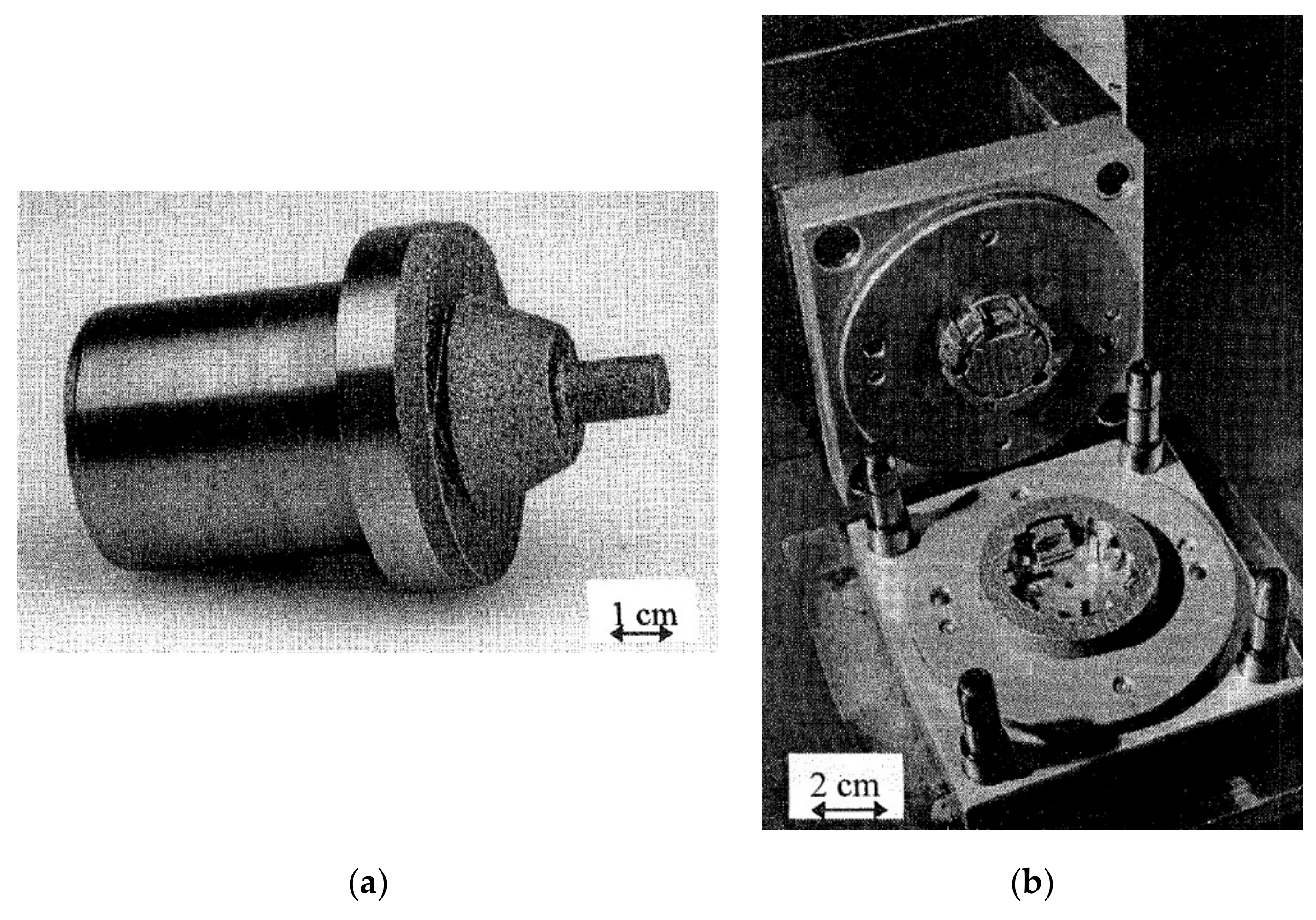
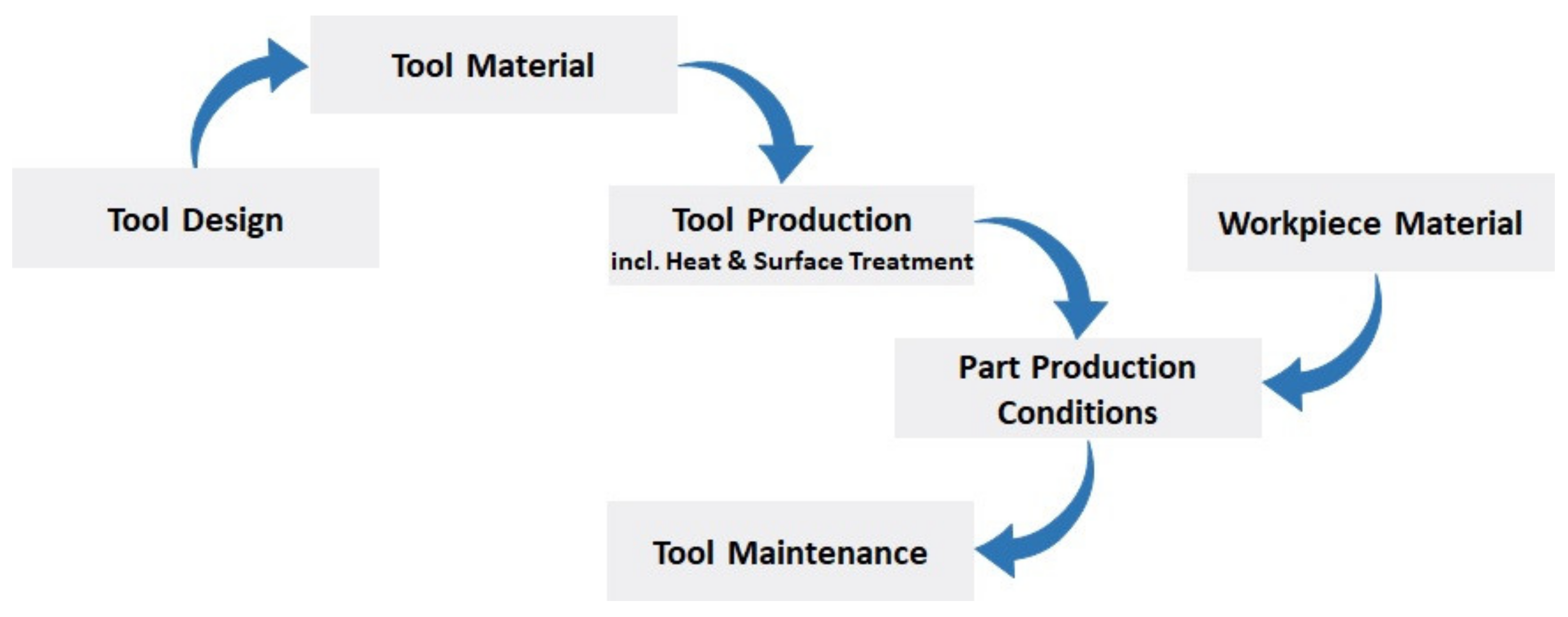

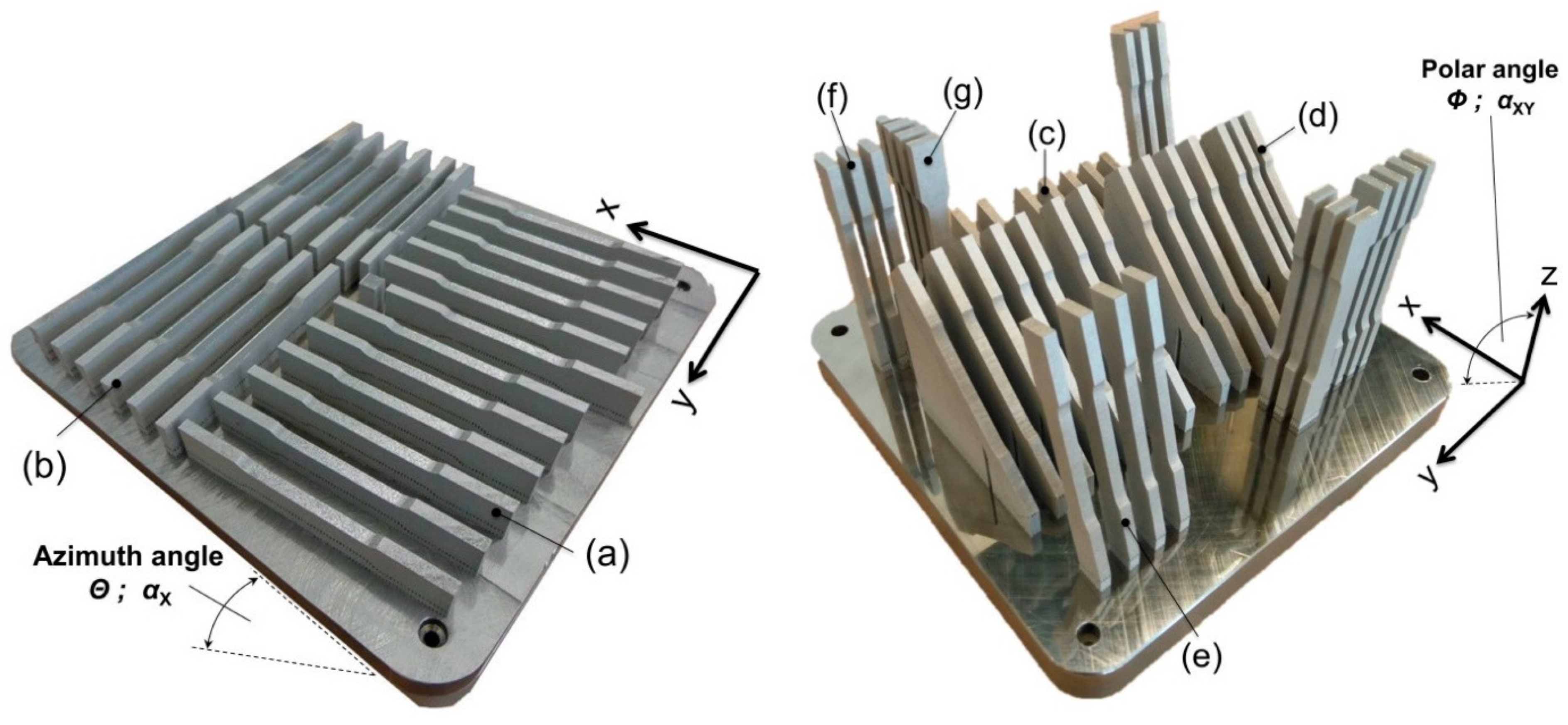
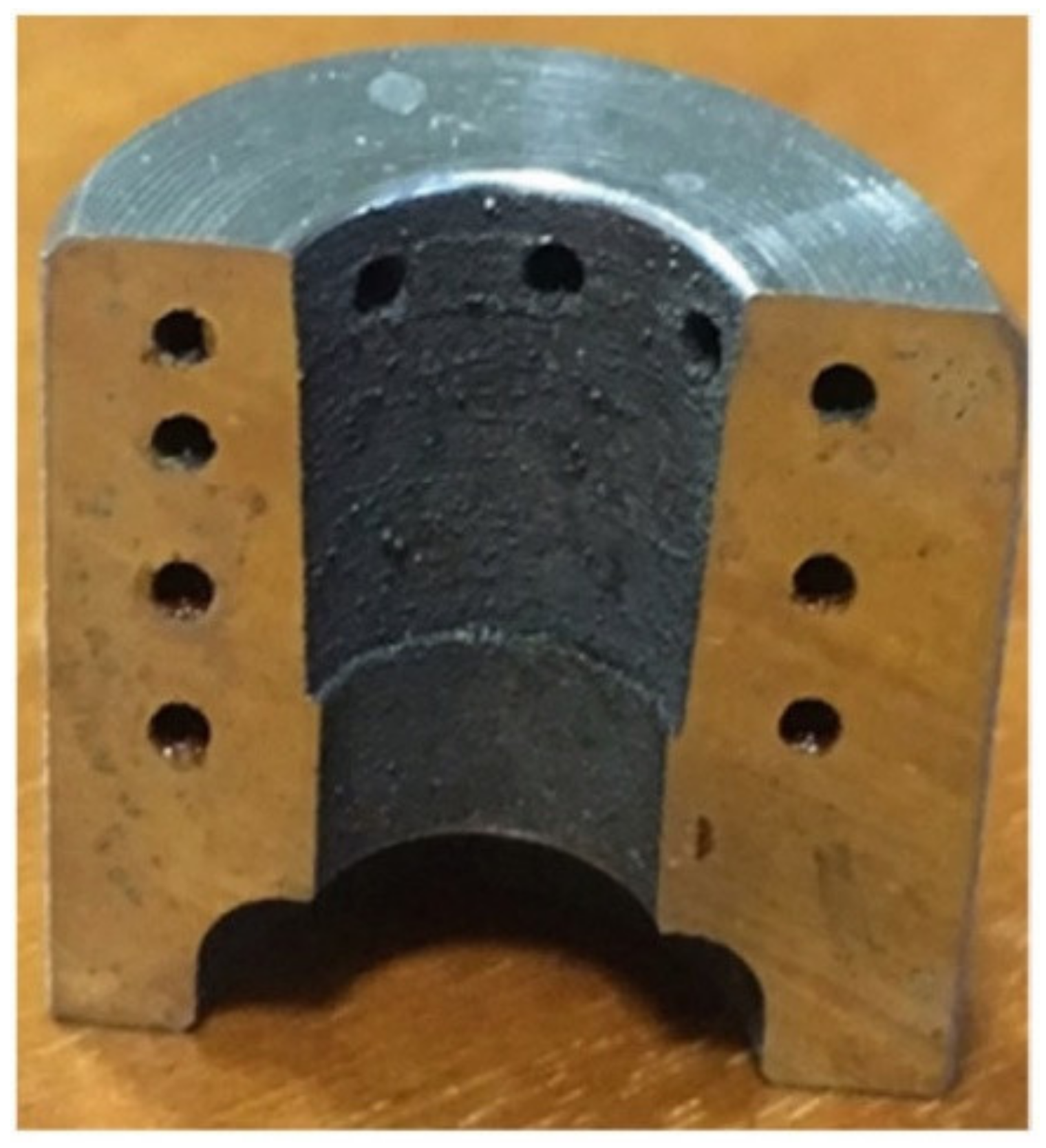
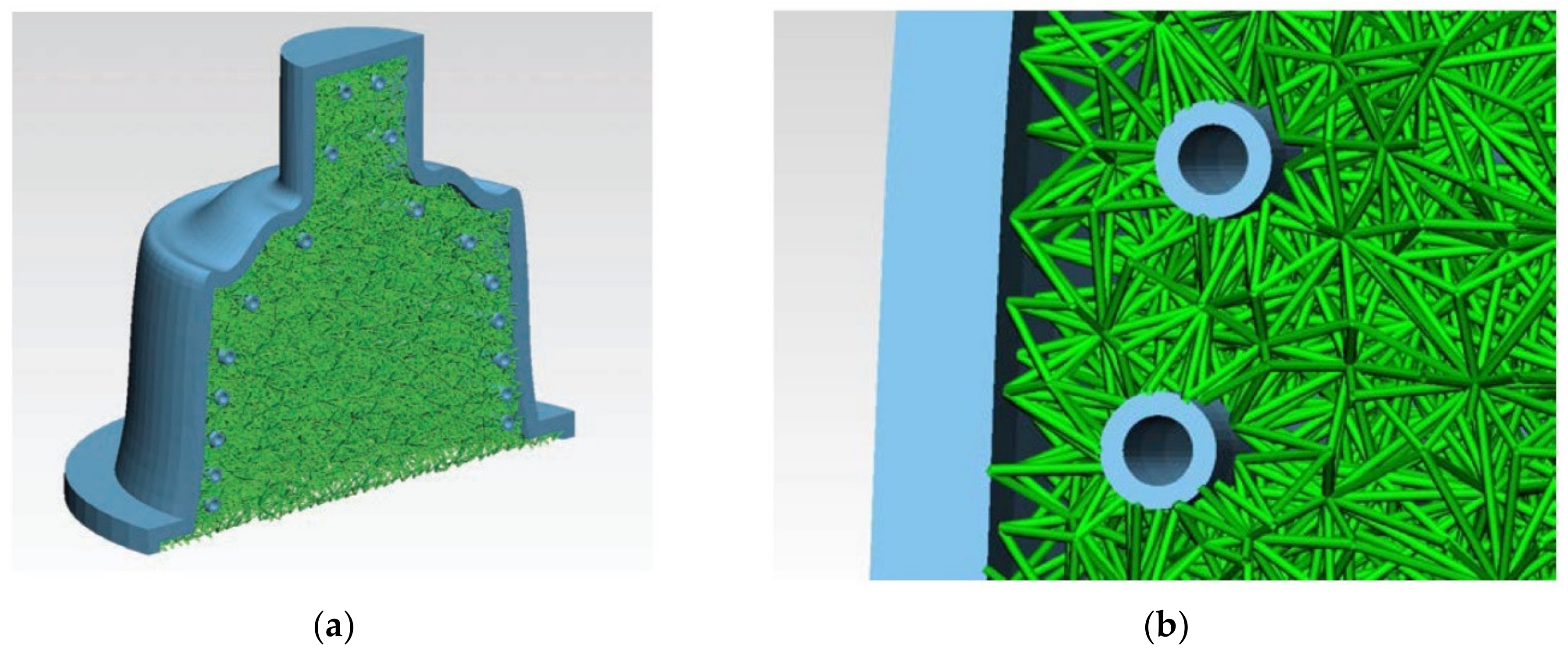
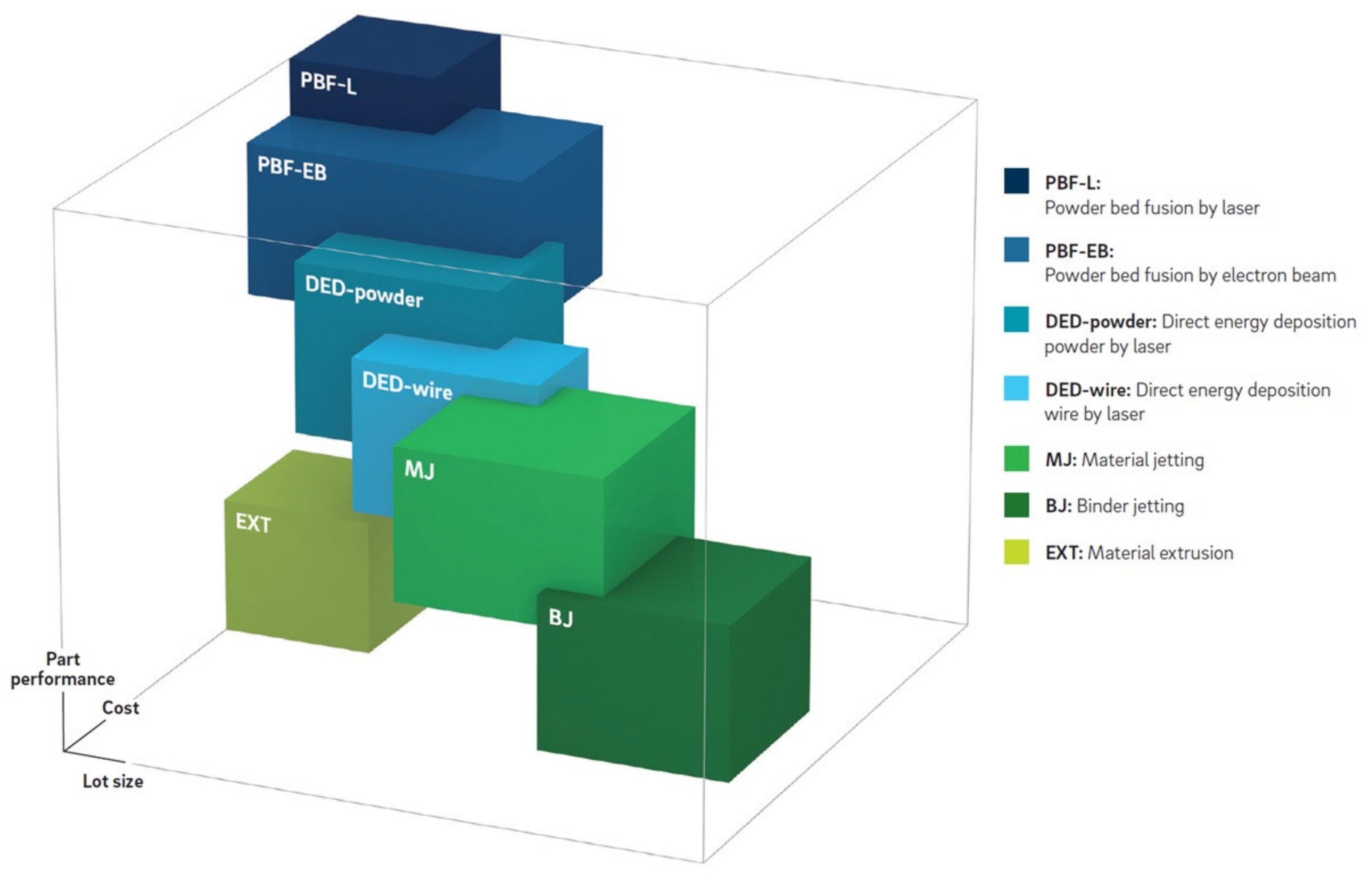
| AISI Classification | Prefix (AISI Standards) | Important Group Characteristics | Principal Alloying Elements | Examples of Applications |
|---|---|---|---|---|
| High speed steels | M (Mo type) | High hardness for high speed cutting of materials, red hardness. | C, Mo, W, V, Cr | Cutting (material removal) tools. |
| T (W type) | C, W, V, Cr, Co | |||
| Cold-work steels | A (medium alloy air hardening) | Deep hardening in air (up to 100 mm). | C, Mn, Cr, Mo | Tools/dies/punches for blanking, coining and forming. |
| D (high C, high Cr) | High wear resistance at normal temperatures. | C, Cr, (Mo) | ||
| O (oil hardening) | High wear resistance at normal temperatures. | Varies | ||
| W (water hardening) | Group W exhibits higher toughness than group L. | C | Woodworking tools, coining tools. | |
| Hot-work steels | H (Cr type) | Deep hardening, high toughness. | C, Cr, W, (V) | Dies for extrusion of Al and Mg. Hot rolling, hot forging. |
| H (W type) | Greater thermal stability than the Cr type. Properties similar to high speed steels. | C, W, V, Cr, Co | Hot rolling, hot forging. Extrusion dies for brass, Ni alloys and steels. | |
| H, (Mo type) | C, Mo, W, V, Cr, Co | |||
| Shock-resisting steels | S | High shock loading resistance. | Mn, Si, Cr, W, Mo | Chisels, hammers, and punches. |
| Mold steels | P | Low softening resistance at elevated temperature. | Cr, Ni | Molds, Critical finish molds. |
| Special purpose steels | L | Low alloyed steels. | Cr, V, Ni, Mo | Various. |
| Class | Material | Used 3D Printer | Layer Thickness (μm) | Laser Power (W) | Scan Speed (mm/s) | Hatch Distance (μm) | Scan Stratgey | Ref. |
|---|---|---|---|---|---|---|---|---|
| Maraging steel | 18Ni-300 (DIN 1.2709) | 3D Systems ProX DMP 300 | 40 | 185 | 1200 | 70 | Line | [62], see also [91] |
| M789 AMPO | Trumpf TruPrint 1000 | 20 | 160 | 763 | 87 | NA | [92] | |
| Stainless steel | 316L (DIN 1.4404) | Renishaw AM250 | 50 | 200 | 1000 | 100 | Stripe pattern, 20 mm overlap | [87], See also [88,91] |
| 17-4PH (DIN 1.4542) | 3D SystemsProX DMP 300 | 40 | 150 | 1200 | 50 | NA | [89] See also [90] | |
| 420 (DIN 1.4021) | Concept Laser Mlab R | 20 | 90 | 600 | 120 | Line, 90° rotation (−45°/+ 45°) | [56] | |
| Tool steel | M2 (DIN 1.3343) | Concept Laser M3 Linear | 30 | 105 | 150 | 128 | Island (chess) | [58] |
| H13 (DIN 1.2344) | SLM250HL | 30 | 175 | 607.64 | 120 | NA | [59], see also [91] | |
| P20 (DIN 1.2311) | DiMetal-100 | 30 | 160 | 350 | 80 | NA | [60], see also [91] | |
| AM Corrax | EOS M290 | 30 | 170 | 1250 | 100 | Line | [62], See also [61] |
| Problem | Primary Approach | Secondary Approach |
|---|---|---|
| Build defects | - | - |
| Keyhole porosity | Reduce laser power | Increase laser velocity Remelting/reheating |
| Lack-of-fusion porosity | Reduce scan line spacing Reduce layer thickness | Reduce laser velocity Increase laser power Remelting/reheating |
| Composition change | Reduce laser power Increase laser velocity | Increase scan line spacing Increase layer thickness |
| Residual stress and distortion | Reduce scan vector length Use heated substrate/chamber | Reduce laser velocity |
| Microstructural/materials related | - | - |
| Microsegregation | Increase laser velocity | Strongly reduce laser velocity |
| Undesired texture | Reduce laser velocity | Reduce laser power |
| Coarse/columnar grains | Reduce laser velocity | Reduce laser power |
| Meta-stable phases (e.g., martensite) | Remelting/reheating | Reduce laser velocity |
| Config. | Polar Angle Φ; αXY (°) | Azimuth Angle Θ; αX (°) | Total Runtime (h) |
|---|---|---|---|
| (a) | 0 | 0 | - |
| (b) | 0 | 90 | 39.5 |
| (c) | 15 | 0 | - |
| (d) | 45 | 0 | - |
| (e) | 75 | 0 | 86.5 |
| (f) | 90 | 0 | - |
| (g) | 90 | 90 | - |
| Config. | Young’s Modulus | Yield Strength | Ultimate Tensile | Elongation at | Poisson’s Ratio | |||||
|---|---|---|---|---|---|---|---|---|---|---|
| E (GPa) | Rp0.2 (MPa) | Strength Rm (MPa) | Failure At (%) | ν (-) | ||||||
| Average | STDEV | Average | STDEV | Average | STDEV | Average | STDEV | Average | STDEV | |
| (a) | 151.01 | 25.56 | 516.51 | 7.16 | 634.43 | 7.39 | 33.24 | 0.57 | 0.444 | 0.031 |
| (b) | 207.57 | 24.22 | 539.47 | 3.29 | 643.67 | 3.25 | 42.74 | 0.82 | 0.155 | 0.014 |
| (c) | 147.87 | 23.59 | 501.32 | 7.70 | 624.65 | 4.36 | 34.09 | 1.12 | 0.479 | 0.058 |
| (d) | 227.35 | 25.12 | 589.89 | 11.86 | 698.98 | 23.65 | 32.56 | 10.17 | 0.203 | 0.024 |
| (e) | 151.43 | 18.80 | 485.65 | 11.93 | 571.23 | 18.63 | 22.84 | 7.27 | 0.558 | 0.020 |
| (f) | 137.78 | 14.25 | 438.60 | 9.69 | 511.99 | 17.95 | 11.76 | 5.38 | 0.453 | 0.005 |
| (g) | 137.83 | 16.25 | 457.21 | 17.29 | 530.22 | 8.09 | 17.46 | 4.42 | 0.170 | 0.085 |
Publisher’s Note: MDPI stays neutral with regard to jurisdictional claims in published maps and institutional affiliations. |
© 2021 by the author. Licensee MDPI, Basel, Switzerland. This article is an open access article distributed under the terms and conditions of the Creative Commons Attribution (CC BY) license (http://creativecommons.org/licenses/by/4.0/).
Share and Cite
Asnafi, N. Application of Laser-Based Powder Bed Fusion for Direct Metal Tooling. Metals 2021, 11, 458. https://doi.org/10.3390/met11030458
Asnafi N. Application of Laser-Based Powder Bed Fusion for Direct Metal Tooling. Metals. 2021; 11(3):458. https://doi.org/10.3390/met11030458
Chicago/Turabian StyleAsnafi, Nader. 2021. "Application of Laser-Based Powder Bed Fusion for Direct Metal Tooling" Metals 11, no. 3: 458. https://doi.org/10.3390/met11030458
APA StyleAsnafi, N. (2021). Application of Laser-Based Powder Bed Fusion for Direct Metal Tooling. Metals, 11(3), 458. https://doi.org/10.3390/met11030458






